Simple Summary
Hoverflies are a diverse group (6200+ species) of two-winged flies that provide important ecosystem services (e.g., plant pollination and regulation of populations of pest insects). The hoverfly genus Eumerus has caught the attention of scientists and entomology amateurs due to its high number of species worldwide (250+) and its wide range of body sizes and shapes. Nevertheless, some species show a similar overall appearance making both their separation from each other and the study of their classification/biology difficult. Thus, the aim of the present work is to update the knowledge of the Eumerus hoverflies in the Iberian Peninsula by assessing the diversity of the Eumerus tricolor group under an integrative approach (i.e., combining different techniques and data sources). We found and described two new species from Spain and provided the most comprehensive identification key for all known European species of this Eumerus group.
Abstract
Eumerus Meigen, 1822 is one of the largest Syrphidae genera in the Palaearctic Region, with the highest levels of taxonomic diversity found in the Eumerus tricolor species group. Despite its high diversity, the interspecific levels of morphological variability can be low. Additionally, some species may show certain levels of intraspecific variability. Hence, species delimitation may become challenging. In this work, we assessed the diversity of the E. tricolor group in the Iberian Peninsula through an integrative analysis of nomenclature, morphology and the 5′ (COI-5′) and 3′ (COI-3′) end regions of the Cytochrome c oxidase subunit I gene. Two new species, Eumerus ancylostylus Aguado-Aranda & Ricarte sp. n. and Eumerus petrarum Aguado-Aranda, Nedeljković & Ricarte sp. n., were described, and their intra- and interspecific variations discussed. In addition, the first barcodes of Iberian members of the E. tricolor group were obtained, and the distribution ranges of all species were mapped within the study area. The systematic position of the new species is discussed based on the resulting COI-based trees. The male genitalia of Eumerus hispanicus van der Goot, 1966 and Eumerus bayardi Séguy, 1961 were studied and illustrated. A lectotype was designated for Eumerus lateralis (Zetterstedt, 1819). An updated dichotomous key for all known European species of the E. tricolor group is provided. The egg of E. petrarum sp. n. is also described.
1. Introduction
The Syrphidae is one of the best-known Diptera families, especially in Europe [1]. Recent works report a great morphological and genetic complexity in this family at different taxonomic levels (e.g., [2,3]). Thus, species delimitation becomes difficult in taxonomically complex groups [4], especially when cryptic species (i.e., species with identical or very similar morphology) are involved [5]. Cases of cryptic speciation are found in various genera of hoverflies (e.g., [6,7]). Furthermore, phylogenetically-related cryptic species (i.e., sibling species sensu Knowlton [8]) have also been reported within the Syrphidae, mainly for genera with high species richness, such as Merodon Meigen, 1803 [9].
The genus Eumerus Meigen, 1822 (Eristalinae: Merodontini) is one of the most diverse among hoverflies worldwide [10]. In total, 11 species groups are known to be present in the European continent, of which the Eumerus tricolor (Fabricius, 1798) group is the most species-rich [11]. This group was proposed by Chroni et al. [12] based on COI mitochondrial DNA. Grković et al. [13] defined it morphologically in order to include species with the following combination of features: large and, predominantly, black body, but abdomen usually with red parts; basoflagellomere square-shaped or oval, more or less striated and with a flattened ellipsoidal area distally; in males, eyes dichoptic or slightly holoptic; anterior surstylar lobe of male genitalia poorly developed; interior accessory lobe of male genitalia wing-shaped and densely pilose. This diagnosis has been updated in later studies as some characters (e.g., the coloration of body hairs) appeared to be variable amongst species [14]. Within the E. tricolor group, the Eumerus binominatus Hervé-Bazin, 1923 subgroup was defined by Grković et al. [15]. All species of this subgroup share the apomorphic characters of the E. tricolor group but differ in the shape and length of the legs, which are conspicuously thin and slender. The number of species belonging to the E. tricolor group is continually increasing in the Palaearctic Region (e.g., [11,16]). Regarding their conservation, only the European species of the E. tricolor group have been assessed according to IUCN Red List Categories and Criteria [17].
The Ibero-Balearic region (mainland Portugal and Spain, plus Andorra, Gibraltar and the Balearic Islands) hosts a great diversity of hoverflies, with 420+ species recorded [18,19,20,21]. The genus Eumerus is particularly diverse in the Ibero-Balearic region, with 37 species reported, of which 7 are endemic [22,23,24]. Nowadays, 9 species groups and a number of “individual species” (not assigned to a species group) have representation in the Ibero-Balearic area, with the E. tricolor group having the highest number of species included [22,24]: Eumerus azabense Ricarte & Marcos-García in Ricarte et al., 2018, Eumerus grallator Smit in Grković et al., 2019a, Eumerus grandis Meigen, 1822, Eumerus hispanicus van der Goot, 1966, Eumerus larvatus Aracil, Grković & Pérez-Bañón in Aracil et al., 2023, Eumerus ovatus Loew, 1848, Eumerus sabulonum (Fallén, 1817), Eumerus tarsalis Loew, 1848 and E. tricolor.
Recent findings of new species of Eumerus in the Iberian Peninsula [14,23,24,25] suggest that the Eumerus diversity from this area might be underestimated, especially for the highly diverse E. tricolor group, which has been poorly explored in this region. Thus, in the framework of an ongoing taxonomic revision of the Ibero-Balearic Eumerus, the objectives of the present work are to assess the diversity of this species group and to explore the taxonomy and systematic position of its species through an integrative approach.
2. Materials and Methods
2.1. Study Area
The Ibero-Balearic area, with an extension of more than 600,000 km2, is located in south-western Europe. Two biogeographical regions are represented in the Iberian territory: the Euro-Siberian and the Mediterranean [26]. The first one is restricted to the northernmost areas encompassing rainy, mountainous landscapes where the Pyrenees and the Cantabrian Mountain Range are found. Otherwise, the Mediterranean region includes a vast mosaic of habitats [27]. In the framework of the present study, two Pyrenean enclaves of Spain (‘valle de Camprodrón’, in Girona province and ‘Refugio de Belagua,’ in Navarra province) were surveyed, as well as various localities in south-eastern Spain, mainly along the Baetic System: ‘Sierra de Aitana,’ ‘Sierra del Maigmó,’ and ‘Sierra de Mariola’ in Alicante province, ‘Sierra de Gádor,’ in Almería province and ‘Sierra Nevada,’ in Granada province.
2.2. Examined Material
A total of 219 adult specimens of 11 species of the E. tricolor group were studied in the present work. New material was collected in different Iberian localities (see Study area) and European countries by hand net, Malaise trap and pan trap. We also studied eggs of Eumerus aff. sabulonum laid within a plastic tube where a female was introduced upon capture in the field. Material deposited in the following entomological collections was also examined: the private collection of André P.W. van Eck (AET, Tilburg, The Netherlands); ‘Colección Entomológica de la Universidad de Alicante’ (CEUA-CIBIO, Alicante, Spain); the Canadian National Collection of Insects, Arachnids and Nematodes (CNC, Ottawa, ON, Canada); Melbourne Museum (MMV, Museums Victoria, Australia); ‘Museo Nacional de Ciencias Naturales’ (MNCN, Madrid, Spain); Museum of Zoology (MZLU, University of Lund, Sweden); Naturalis Biodiversity Centre (NBC, Leiden, The Netherlands); private collection of Sander Bot (PSB, Haren, The Netherlands); the private collection of Jeroen van Steenis (PJSA, Amersfoort, The Netherlands).
All specimens were databased in an excel table. A unique bar code label was assigned to the new material added to the CEUA-CIBIO collection. In the examined material lists, data from different labels of the same specimen are separated by a single forward slash (/). Collection acronyms are indicated in brackets. A semicolon (;) is used for separating the collection code labels of different specimens with the same locality data. Additional information not specified in the labels is indicated in curly brackets ({}). The information on the examined specimens is detailed in a supplementary file (see Supplementary material S1), except for that of the new species, which is included in the main text document. A distribution map with all known Iberian records of species of the E. tricolor group was produced with the software QGIS v3.22.16 [28], for which both published and new data were considered. Taking into consideration the diagnosis of the E. tricolor group [13], a comprehensive review of the species descriptions available in the literature was performed to produce a preliminary list of all putative Palaearctic species of this group.
2.3. Morphological Study
All species were, at the first stage, identified with the available dichotomous keys for Eumerus [15,29,30,31]. For the undescribed species not suiting the species included in the keys, their taxonomic statuses were investigated. In the new species descriptions, first, a diagnosis was provided and second, a detailed morphological description of males (based on the holotype) and females, if available. Then, species distribution, biology and special remarks of the new species are indicated. To complete the new species descriptions, the following measures were taken on several adult specimens (‘n’) with the software Leica Application Suite X (LAS X) ® v3.0.4.16529: Body length (‘l’); basoflagellomere ratio (length:width; see figure 4a of Aguado-Aranda et al. [23]); and the maximum width of the vertical triangle (‘vtw’) measured at a mid-point on the ocellar triangle. Male genitalia were dissected and prepared following Ricarte et al. [32] and then stored in glycerine in plastic microvials. All photographs of the specimens and male genitalia were taken with a Leica DFC 450 camera attached to a Leica M205 C binocular microscope. Male genitalia of Eumerus bayardi Séguy, 1961, E. hispanicus, E. sabulonum and Eumerus aff. sabulonum were hand drawn from printed photographs.
For eggs of Eumerus aff. sabulonum, a detailed description of their external surface was undertaken from images of scanning electron microscopy (SEM). The eggs were fixed and preserved in ethanol 70%. They were dehydrated using an ethanol/water series of 2 baths of 70% for 5 min each, followed by one bath of 80%, 90% and 96% ethanol for 5 min each and 2 baths in absolute ethanol of 5 min each. The dehydrated eggs were mounted on aluminum stubs with a double-sided adhesive carbon tape and sputter-coated in a Quorum 150 T ES Plus with a 30 nm layer of platinum. The photographed egg was not uniformly turgid. The images were taken with a Jeol JSM-ITH500HT at 3.0 kV accelerating voltage.
Morphological terminology used in the adult descriptions follows Thompson [33] except for the term “hair/s,” which is used in replacement of “pilis/pile,” as well as the terms “fossette” and “notopleural sulcus” which follow Doczkal & Pape [34]. The terminology for male genitalia follows Doczkal [35], and for egg follows Chandler [36]. For those illustrations cited from the literature (not shown in the present paper), ‘figure’ (lower case) is used, while ‘Figure’ (upper case) is used for those which are original from this work (shown in the present paper).
2.4. Molecular Study
DNA was extracted both from 1 mesoleg and 1 metaleg of 2 males of Eumerus aff. grandis, 3 specimens (2 males and 1 female) of E. grallator, 2 specimens (1 male and 1 female) of E. hispanicus, 8 specimens (5 males and 3 females) of Eumerus aff. sabulonum, 5 specimens (4 males and 1 female) of E. sabulonum, 1 male of E. tarsalis and 2 specimens (1 male and 1 female) of E. tricolor. DNA of one male of Eumerus aff. grandis (code CEUA00017798) and two males of E. grandis were extracted from a wing. The NZY Tissue gDNA Isolation kit, following the manufacture’s protocol for animal tissues, was used for two males of Eumerus aff. grandis and all specimens of E. grallator, E. hispanicus, E. sabulonum, Eumerus aff. sabulonum, E. tarsalis and E. tricolor. Otherwise, the DNA of 1 male of Eumerus aff. grandis (code CEUA00017798), 2 males of E. bayardi and 2 males of E. grandis was extracted using the QIAGEN DNeasy Blood and Tissue kit with some modifications in the manufacturer’s protocol.
PCR amplifications of the 5′ (COI-5′) and 3′ (COI-3′) end regions of the Cytochrome c oxidase subunit I gene were performed using universal and custom primers (Table 1). The COI-5′ fragments “A,” “B” and “C” were amplified for “older” specimens (collection date previous to the year 2000) in which DNA is heavily fragmented and “recent” specimens of which the complete COI-5′ was not achieved to amplify. All amplifications were carried out in a total volume of 25 µL containing 1 × of Buffer reaction, 0.4 mM of dNTPs, 0.2 µM of each primer, 0.65–2 mM of MgCl2 and 1–2 units of DNA polymerase. Thermocycler conditions followed those used by Grković et al. [37] and Grković et al. [25] for COI-5′, and Chroni et al. [12], but with annealing at 48 °C, for COI-3′. Otherwise, the PCR profile for the barcodes of E. bayardi, all fragments of COI-5′ and COI-3′ (specimen vouchers CEUA_S71–72, S83–84, S86–87, S93 and S231–232) consisted of an initial denaturalization of 3 min at 94 °C; 45 cycles of 45 s at 94 °C, annealing of 45 s at 45 °C and 1 min at 72 °C; with a final elongation step of 5 min at 72 °C.
All PCR products were visualized with an electrophoresis process in a 1–1.5% agarose gel, except those of E. bayardi, which were visualized and purified in an E-Gel CloneWell 0.8% agarose gel (Life Technologies Corporation, Austin, TX, USA). Purifications of COI-5′ fragments and COI-3′ (vouchers above indicated) products followed the USB® ExoSAP-IT® method (Affymetrix, Inc., Santa Clara, CA, USA). Sequencing reactions of the fragments, COI-5′ of E. bayardi and COI-3′ products (vouchers above indicated) were carried out with the BigDyeTM Terminator v3.1 Cycle Sequencing kit (Thermo Fisher Scientific, Inc., Waltham, MA, USA). The rest of the PCR products were purified and sequenced at Macrogen (Macrogen, Inc., Seoul, Republic of Korea).
The sequences were edited by eye with the program Sequencher v5.4.6 (Gene Codes Corporation 2017, Ann Arbor, MI). Then, COI-5′ and COI-3′ sequences of Eumerus alpinus Rondani, 1857, Eumerus minotaurus Claussen & Lucas, 1988, Eumerus sogdianus Stackelberg, 1952 and at least one male and female specimen of each European species of the E. tricolor group available at the public repositories GenBank and BOLD [38] were downloaded (see Supplementary Material S2). Alignments were performed manually and checked with the program AliView v1.25 [39]. The final COI-5′ and concatenated (COI-5′+COI-3′) matrices had lengths of 569 and 1289 bp, respectively. Then, Neighbor-Joining (NJ) and Maximum Likelihood (ML) analyses for both datasets were carried out in MEGA7 [40] with 1000 bootstrap replications using the Maximum Likelihood Composite and General Time Reversible (GTR) models, respectively. A GTR+G model (with gamma distribution) was used for the COI-5′ matrix, and a GTR+G+I model (with invariant sites) was used for the COI (COI-5′+COI-3′) matrix. The resulting trees were rooted based on a Xanthogramma citrofasciatum (De Geer, 1776) sequence.

Table 1.
List of primers used in the molecular study of the E. tricolor species group.
Table 1.
List of primers used in the molecular study of the E. tricolor species group.
| Gene Region | Primer | Sequence | Reference |
|---|---|---|---|
| COI-5′ (complete) | LCO1490 | 5′-GGTCAACAAATCATAAAGATATTGG-3′ | [41] |
| HCO2198 | 5′-TAAACTTCAGGGTGACCAAAAAATCA-3′ | ||
| COI-5′ (“A”) | Heb-F | 5′-GGTCAACAAATCATAAAGATATTGG-3′ | [41] |
| 1762-R | 5′-CGDGGRAADGCYATRTCDGG-3′ | Kelso (in prep.) | |
| COI-5′ (“B”) | 342-F | 5′-TGTAAAACGACGGCCAGTGGDKCHCCNGAYATRGC-3′ | Kelso (in prep.) |
| 1976-R | 5′-GWAATRAARTTWACDGCHCC-3′ | ||
| COI-5′ (“C”) | 1957-F | 5′-GGDATWTCHTCHATYYTAGG-3′ | Kelso (in prep.) |
| 780-R | 5′-CCAAAAAATCARAATARRTGYTG-3′ | [42] | |
| COI-3′ | 780-F | 5′-CARCAYYTATTYTGATTTTTTGG-3′ | Kelso (in prep.) |
| C1-J-2183 (Jerry) | 5′-CAACATTTATTTTGATTTTTTGG-3′ | [43] | |
| TL2-N-3014 (Pat) | 5′-TCCAATGCACTAATCTGCCATATTA-3′ |
3. Results
3.1. Integrative Approach
As a result of the literature review, 66 species of the E. tricolor group were found to occur in the Palaearctic Region (Table 2). Regarding the Ibero-Balearic area, 128 new specimens were collected of the following species: 2 males of Eumerus aff. grandis, 1 male of E. azabense, 1 male of E. bayardi, 26 specimens of E. grallator (25 males and 1 female), 4 specimens of E. hispanicus (3 males and 1 female), 31 specimens of E. sabulonum (27 males and 4 females), 41 specimens of Eumerus aff. sabulonum (36 males and 5 females), 5 males of E. tarsalis and 17 specimens of E. tricolor (13 males and 4 females). In the molecular analyses, 21 species of the E. tricolor group were considered in the COI-5′ dataset and 17 species in the COI (COI-5′+COI-3′) dataset (see Supplementary Material S2). Apart from those of the undescribed species (Eumerus aff. sabulonum, Eumerus aff. grandis), we generated the first known COI sequences for the following species: E. bayardi, E. grallator, E. hispanicus, E. sabulonum and E. tarsalis. In addition, we also obtained new COI sequences for E. grandis and COI-5′ for E. tricolor. All resulting trees had virtually the same topologies (Figure 1 and Figure 2). The COI-based trees showed the highest bootstrap values (>70) for the two new species that clustered in single clades (Figure 2), supporting our morphological hypotheses. Therefore, based on the combination of the nomenclatural, morphological and molecular evidence, the new species were characterized.

Table 2.
Preliminary list of the Palaearctic species of the E. tricolor group according to the reviewed literature, with an indication of their type locality (only country/region). For the European species, the category assigned in the European Red List of Hoverflies is also indicated. Eumerus afrarius Séguy, 1961 and Eumerus lateralis (Zetterstedt, 1819) are omitted from this list due to their uncertain taxonomic status. The species of the E. binominatus subgroup are indicated with an asterisk. Legend: Not Evaluated (NE), Least Concern (LC), Vulnerable (VU), Endangered (EN), Critically Endangered (CR).
Table 2.
Preliminary list of the Palaearctic species of the E. tricolor group according to the reviewed literature, with an indication of their type locality (only country/region). For the European species, the category assigned in the European Red List of Hoverflies is also indicated. Eumerus afrarius Séguy, 1961 and Eumerus lateralis (Zetterstedt, 1819) are omitted from this list due to their uncertain taxonomic status. The species of the E. binominatus subgroup are indicated with an asterisk. Legend: Not Evaluated (NE), Least Concern (LC), Vulnerable (VU), Endangered (EN), Critically Endangered (CR).
| Species | Type Locality | IUCN Red List Category |
|---|---|---|
| E. alajensis Peck, 1966 | Kyrgyzstan | ⸺ |
| E. ancylostylus Aguado-Aranda & Ricarte, sp. n. | Spain | ⸺ |
| E. arctus van Steenis in Grković et al., 2021 | Switzerland | NE |
| E. arkadii Mutin in Mutin & Barkalov, 1999 | Russia | ⸺ |
| E. arkitensis Peck, 1969 | Kyrgyzstan | ⸺ |
| E. armatus Ricarte & Rotheray in Ricarte et al., 2012 | Greece | VU |
| E. armenorum Stackelberg, 1960 | Armenia | ⸺ |
| E. atricolorus Gilasian & van Steenis in Gilasian et al., 2020 | Iran | ⸺ |
| E. aurofinis Grković, Vujić & Radenković in Grković et al., 2016 | Greece | EN |
| E. azabense Ricarte & Marcos-García in Ricarte et al., 2018 | Spain | CR |
| E. badkhyziensis Mutin, 2019 | Turkmenistan | ⸺ |
| E. bayardi Séguy, 1961 | France | ⸺ |
| E. binominatus Hervé-Bazin, 1923* | Kazakhstan | ⸺ |
| E. brevipilosus Gilasian & van Steenis in Gilasian et al., 2020 | Iran | ⸺ |
| E. chekabicus Gilasian & van Steenis in Gilasian et al., 2020 | Iran | ⸺ |
| E. coeruleithorax Peck, 1969 | Kazakhstan | ⸺ |
| E. coeruleus (Becker, 1913) | Iran | ⸺ |
| E. compertus Villeneuve in Villeneuve & Gauthier, 1924 | Tunisia | ⸺ |
| E. crispus Vujić & Grković in Grković et al., 2021 | Serbia | NE |
| E. falsus Becker, 1922 | Syria | ⸺ |
| E. grallator Smit in Grković et al., 2019a* | Spain | VU |
| E. grandis Meigen, 1822 | Europe | LC |
| E. grisescens Becker, 1921 | Russia | ⸺ |
| E. hispanicus van der Goot, 1966 | Spain | VU |
| E. hissaricus Stackelberg, 1949 | Tajikistan | ⸺ |
| E. jacobsoni Becker in Becker & Stein, 1913 | Iran | ⸺ |
| E. kazanovzkyae Paramonov, 1927 | Azerbaijan | ⸺ |
| E. kirgisorum Peck, 1966 | Kyrgyzstan | ⸺ |
| E. kopetdagicus Barkalov & Mutin, 2022 | Turkmenistan | ⸺ |
| E. larvatus Aracil, Grković & Pérez-Bañón in Aracil et al., 2023 | Spain | ⸺ |
| E. leleji Mutin, 2016 | Khakassia | ⸺ |
| E. longitarsis Peck, 1979* | Tajikistan | ⸺ |
| E. lunatus (Fabricius, 1794) | North Africa | ⸺ |
| E. mucidus Bezzi, 1921 | Africa | ⸺ |
| E. nigrifacies Becker, 1921 | Russia | ⸺ |
| E. nigrorufus Grković & Vujić in Grković et al., 2021 | Montenegro | NE |
| E. niveitibia Becker, 1921 | Bulgaria | VU |
| E. ovatus Loew, 1848 | Europe | EN |
| E. ovoformus Gilasian & van Steenis in Gilasian et al., 2020 | Iran | ⸺ |
| E. palaestinensis Stackelberg, 1949 | Israel | ⸺ |
| E. pamirorum Stackelberg, 1949 | Tajikistan | ⸺ |
| E. pavlovskii Stackelberg, 1964 | Armenia | ⸺ |
| E. persarum Stackelberg, 1961 | Iran | ⸺ |
| E. persicus Stackelberg, 1949 | Iran | ⸺ |
| E. petrarum Aguado-Aranda, Nedeljković & Ricarte, sp. n. | Spain | ⸺ |
| E. pilosipedes Gilasian & van Steenis in Gilasian et al., 2020 | Iran | ⸺ |
| E. platycodon Choi & Hong in Choi et al., 2021 | South Korea | ⸺ |
| E. richteri Stackelberg, 1960 | Azerbaijan | ⸺ |
| E. rubrum Grković & Vujić in Grković et al., 2017 | Greece | EN |
| E. rubescens Villeneuve, 1912 | Syria | ⸺ |
| E. rufipilus Peck, 1969 | Kyrgyzstan | ⸺ |
| E. rufomaculatus Peck, 1966 | Kyrgyzstan | ⸺ |
| E. ryzhik Barkalov & Mutin, 2022 | Uzbekistan | ⸺ |
| E. sabulonum (Fallén, 1817) | Sweden | LC |
| E. selevini Stackelberg, 1949 | Kazakhstan | ⸺ |
| E. sinuatus Loew, 1855 | Austria | EN |
| E. tadzhikorum Stackelberg, 1949* | Tajikistan | ⸺ |
| E. tarsalis Loew, 1848 | Europe | EN |
| E. tauricus Stackelberg, 1952 | Ukraine | EN |
| E. tenuitarsis Grković & Vujić in Grković et al., 2019a* | Greece | CR |
| E. tricolor (Fabricius, 1798) | Switzerland | LC |
| E. turcmenorum Paramonov, 1927 | Turkmenistan | ⸺ |
| E. urartorum Stackelberg, 1960 | Armenia | ⸺ |
| E. ursiculus Stackelberg, 1949 | Tadzhikistan | ⸺ |
| E. ussuriensis Stackelberg, 1952 | Russia | ⸺ |
| E. vallicolus Gilasian & van Steenis in Gilasian et al., 2020 | Iran | ⸺ |
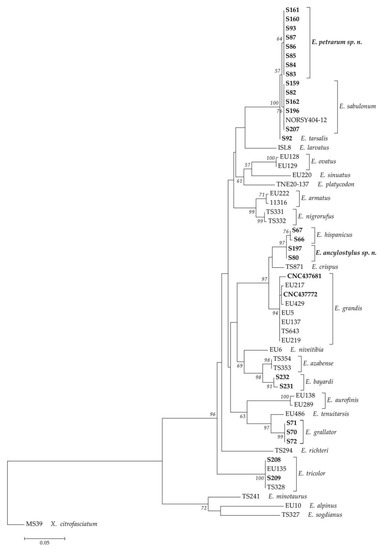
Figure 1.
Maximum Likelihood tree based on COI-5′. DNA vouchers of specimens analyzed for this work are highlighted in bold. Bootstrap values > 50 are shown near nodes. Branch lengths are measured in the number of substitutions per site.

Figure 2.
Neighbor-Joining tree based on COI (COI-5′+COI-3′). DNA vouchers of specimens analyzed for this work are highlighted in bold. Bootstrap values > 50 are shown near nodes. Branch lengths are measured in the number of substitutions per site.
3.2. New Species Descriptions
Eumerus ancylostylus Aguado-Aranda & Ricarte, sp. n. (Figure 3, Figure 4A, Figure 5 and Figure 6A,D)
= Eumerus aff. grandis
urn:lsid:zoobank.org:act:19E89FBD-90F2-4187-A933-F19D846B8CEE
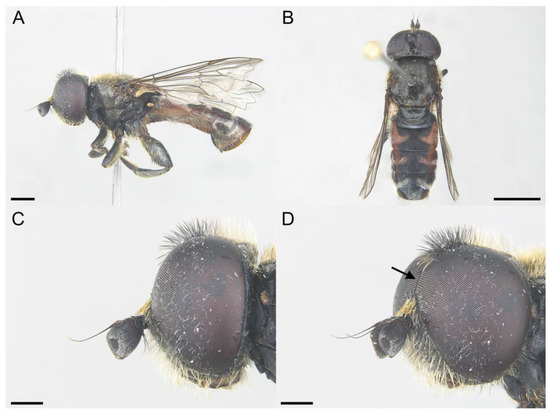
Figure 3.
Eumerus ancylostylus sp. n., male (holotype): (A) Habitus, lateral view. (B) Habitus, dorsal view. (C) Head, lateral view. (D) Eye contiguity (indicated by an arrow). Scale bars = (A) 1 mm; (B) 2 mm; (C,D) 500 µm.
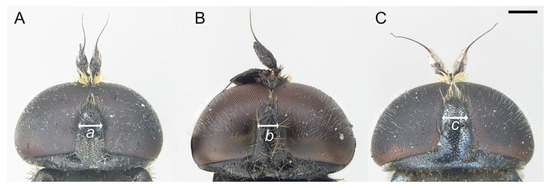
Figure 4.
Male, vertical triangle: (A) E. ancylostylus sp. n. (holotype). (B) E. grandis (specimen from Montenegro). (C) E. lateralis (lectotype). Vertical triangle width (mm): a = 0.58, b = 0.43, c = 0.5. Scale bar = 500 µm.
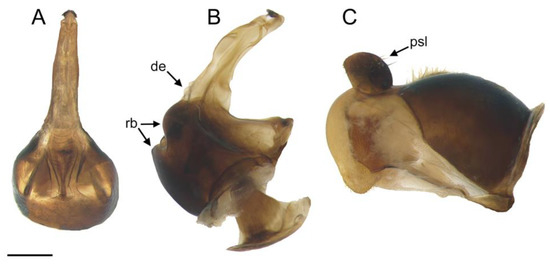
Figure 5.
Eumerus ancylostylus sp. n. (holotype), male genitalia: (A) Hypandrium, ventral view. (B) Hypandrium, lateral view (right side). (C) Epandrium, lateral view (right side). Legend: de, dentate expansion; psl, posterior surstylar lobe; rb, rounded bulges. Scale bar = 250 µm.

Figure 6.
Surstylus, lateral view (right side): (A) E. ancylostylus sp. n. (holotype). (B) E. grandis (specimen from Montenegro). (C) E. lateralis (lectotype). Male genitalia, lateral view (right side): (D) E. ancylostylus sp. n. (E) E. grandis. (F) E. lateralis. An arrow indicates the posterior surstylar lobe, which is enlarged in the images above. Scale bar (D–F) = 250 µm.
- Holotype
SPAIN • ♂—ESPAÑA, Girona, Setcases, camino del depósito de agua, 1317 m, 30-VII-2020, Leg.: A. Ricarte/Eumerus grandis Meigen, 1822, Det. Z. Nedeljković & A. Ricarte/DNA CEUA_S80/CEUA00108275 (CEUA-CIBIO) {as E. grandis, in [44]}.
- Paratypes
SPAIN • 1♂—ESPAÑA, Girona, Setcases, camino del depósito de agua, 1317 m, 02-VIII-2020, Leg.: Z. Nedeljković/Eumerus grandis Meigen, 1822, Det. Z. Nedeljković & A. Ricarte/DNA CEUA_S197/CEUA00108274 (CEUA-CIBIO) {as E. grandis, in [44]} • 1♂—Valle de Casares—LE, 4-VI-87, Mª. A. Marcos-García {leg}/Eumerus annulatus (Panzer), Det.: Mª. A. Marcos-García/Eumerus grandis Meigen, 1822, Det.: A. Ricarte, 2009/DNA CEUA_S275/CEUA00017798 (CEUA-CIBIO) {as E. annulatus, in [45]}.
Diagnosis. This species can be distinguished by the following combination of features (only males, unknown female): large body size (>9.5 mm); eyes hairy and touching along a line (Figure 3C,D); wide vertical triangle (0.58–0.61 mm) (Figure 4A); basoflagellomere trapezoidal in shape; mesonotum with moderately long, golden yellow hairs (Figure 3A), which are of two lengths intermixed on the posterior part, with the shortest hairs surpassing half the length of the longest ones; posterior surstylar lobe arched anteriorly (Figure 6A). This species is most similar to E. grandis (see Taxonomic notes).
Etymology. The specific epithet ‘ancylostylus’ originates from the combination of the Latinised Greek words ‘ankylos’ (curved) and ‘stylos’ (stylus, of the male genitalia) and refers to the curved/round anterior part of the posterior surstylar lobe in male.
Description. MALE (holotype). Measurements (mm): l = 9.56; vtw = 0.58. Head. Eyes contiguous along a line. Eye hairs moderately short and disperse (Figure 3C,D). Face and frontal triangle black; face grey pollinose. Frontal triangle and face covered with dense, golden hairs. Ocellar triangle isosceles. Vertical triangle black; anterior half (including ocellar triangle) with long, erect and black hairs. Apex and posterior half of the vertical triangle covered with whitish-yellow hairs (Figure 3C,D). Occiput black, with whitish yellow hairs which become shorter (than those on the vertical triangle) and whiter toward the laterals; occiput slightly grey pollinose along eye margin and covered in short, black hairs. Scape and pedicel black; pedicel with black hairs ventrally, longer than those on the dorsal side of the scape. Basoflagellomere trapezoidal in shape (length:width ratio = 1:1), slightly striated radially and black; basoflagellomere with a round fossette at the distal margin (Figure 3C). Pedicel and basoflagellomere sparsely white pollinose (pollinosity more obvious under artificial white lighting). Arista black and bare. Thorax. Mesonotum and pleura black. Scutum covered with golden yellow hairs, slightly shorter than those on the vertical triangle; hairs on the posterior half of the scutum almost uniformly long, with the shortest hairs surpassing half of the length of the longest ones; scutum with two medial, white pollinose vittae slightly exceeding the transverse suture; width of the vittae less than 1/8 of the total width of scutum. Notopleural sulcus absent. Disc of scutellum with golden yellow hairs of the same length as that on the scutum; posterior margin of the scutellum with small teeth-like protuberances, each bearing a long black hair apically. Posterior anepisternum, anterior anepimeron and katepisternum on its postero-lateral and ventral areas bearing densely-arranged long golden yellow hairs. Katatergum with a discrete bunch of white hairs. Pleuron grey pollinose except the anterior anepimeron posterolaterally, the upper half of the posterior anepimeron and the katepimeron anterolaterally. Metasternum covered with long, yellowish-white hairs. Femora black; apices of pro- and mesofemora light brown. Tibiae black; pro- and mesotibiae dark brown basally. Tarsi black dorsally and yellow ventrally. Profemur with long, directed backward, golden yellow hairs on its posterior side. Mesofemur with long, directed backward, golden yellow hairs on its posterior side, which are curved at their apex. Pro- and mesofemur with few long, directed backward, black hairs intermixed with the yellow ones on their posterior sides. Metacoxa densely covered with long and white hairs anteriorly and bare posteriorly. Metafemur with dense and yellow hairs, with black hairs postero-apically; hairs on ventral side of the metafemur at least twice the length of the subapical spinae. Metafemur with an anteroventral row of nine spinae and a posteroventral row of six spinae apically. Metatibia with a basoventral ridge covered with short, reclined setae. Wing membrane extensively microtrichose; posterior margin of the wing with dense, short and brown hairs; margin of ventral calypter with rather long and yellow hairs; hairs on the margin of dorsal calypter shorter than those on the ventral calypter; halter brownish yellow. Abdomen. Tergum I black. Terga II-IV black, lateral sides reddish-orange; terga II-IV with a pair of slightly curved, white pollinose maculae. Terga II-IV covered with short, semi-reclined, black hairs. Tergum II with white hairs on lateral margins (hairs at the anterior corners rather long). Tergum III covered with short and black hairs on lateral margins (hairs on the basal part of the maculae white). Tergum IV with short and black hairs on the anterior half of the lateral margins, with white hairs on the posterior half of lateral margins. Sterna I-IV dark brown; anterior margin of sternum I black. Sternum IV flat (without projections); posterior margin of sternum IV slightly V-shaped. Sterna II and III covered with white hairs. Sternum IV covered with short, reclined, white hairs. Genitalia. Epandrium with a simple posterior surstylar lobe, straight posteriorly and rounded anteriorly, and slightly inclined in the direction opposite to cerci. Cercus with long hairs. Hypandrium with two large, round bulges and three little, almost rounded, hyaline expansions at the base (Figure 5B).
FEMALE. Unknown.
Distribution. The Pyrenees and Cantabrian mountain ranges, in the Spanish provinces of Girona and León (Figure 7).
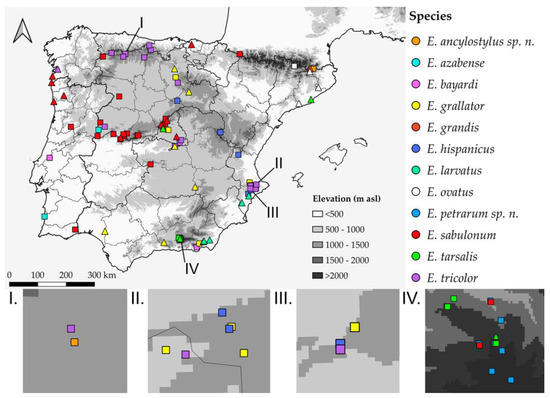
Figure 7.
Distribution ranges of the Iberian members of the E. tricolor species group. Confirmed records are indicated with a square. Unconfirmed published records are indicated with a triangle.
Biology. Adults fly from June to early August at altitudes of over 1300 m asl. The predominant vegetation in the Cantabrian locality of E. ancylostylus sp. n. was mowing meadows and hazelnut woods [46]. The specimens from the Pyrenees were found in a valley, on a side mountain track, amongst vegetation consisting of herbs, scrubs and mixed woodland, and relatively close to a river [44].
Taxonomic notes. The new species resembles morphologically E. grandis, which was described from an undetermined number of specimens from ‘Europe’ (unknown precise locality). The type material of E. grandis is lost [11]. According to Peck [47], E. grandis has two synonyms: Eumerus annulatus, originally described as Syrphus annulatus Panzer, 1798, and Eumerus varius Meigen, 1822. Syrphus annulatus sensu Panzer was revealed to be a primary homonym of S. annulatus Fabricius, 1798, recently synonymized with Merodon natans (Fabricius, 1794) [48]. Grković et al. [11] confirmed the status of E. annulatus (Panzer, 1798) as a synonym of E. grandis. In addition, E. varius was excluded from the list of synonyms of E. grandis since the examined male of E. varius from the supposed type series was actually E. tricolor. This male was designated as lectotype of E. varius in order to stabilize this species concept [11].
Eumerus ancylostylus sp. n keyed out as E. grandis in the keys for the south-eastern European species of the E. tricolor group [11] and in those of the Eumerus from Switzerland and surrounding parts of central Europe [30]. Moreover, the new species keyed out as E. annulatus, later described by Meigen as E. grandis [11], in the Stackelberg’s key for the Palaearctic species of Eumerus [31]. Nevertheless, the new species differs from E. grandis in the basoflagellomere ratio, which is wider in E. ancylostylus sp. n. (1:1–1.1, n = 3) than in E. grandis (1:0.8–0.9, n = 3), the width of the vertical triangle, which is wider in E. ancylostylus sp. n. (Figure 4A,B), the length of the hairs on posterior half of the scutum, which are all almost of equal length in E. ancylostylus sp. n. but clearly different in length in E. grandis (short hairs do not exceed half of the length of the longest hairs) and the shape of the posterior surstylar lobe, rounded anteriorly in E. ancylostylus sp. n. but more square-shaped in E. grandis (Figure 6A,B). In addition, E. ancylostylus sp. n. differs clearly from E. grandis in COI sequences.
We also examined the type material of Eumerus lateralis (Zetterstedt, 1819) (Figure 8), described under the genus Pipiza Fallén, 1810, because Meigen [49] stated in his description of E. grandis: “Whether this species is Pipiza lateralis Falléni (v. Kon. Vet. Ak. Handl. 1819. St. I. Nro. 38) I cannot state for lack of an accurate description of it”. After examination of the type material of E. lateralis (1 male and 1 female), we confirmed that all were conspecific and the male differed from E. ancylostylus sp. n. in the basoflagellomere ratio, which is wider in E. ancylostylus sp. n. (1:1–1.1, n = 3) than in E. lateralis (1:0.8), the width of the vertical triangle, slightly wider (0.1 mm) in the new species (Figure 4A,C), the length of the hairs on posterior half of the scutum, which are all almost of equal length in E. ancylostylus sp. n. but different in length in E. lateralis (short hairs are at most as long as half the length of the longest hairs) and the shape of the posterior surstylar lobe, which is square-shaped in E. lateralis, as in E. grandis (Figure 6B,C). The male from the type series of E. lateralis was designated as lectotype to stabilize the morphological concept of this species. Fresh material of E. lateralis from the type locality or close was not available to us. Given the similarity among these species and in the absence of molecular data on E. lateralis, we cannot confirm if E. lateralis is the same species as E. grandis or not. Nevertheless, based on the morphological similarities, E. lateralis and E. grandis may actually be the same species. Thus, fresh material of E. lateralis should be studied in the future to clarify the taxonomic status of this species.
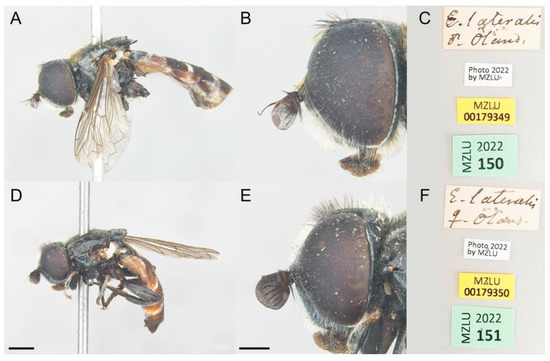
Figure 8.
Eumerus lateralis, male (lectotype): (A) Habitus, lateral view. (B) Head, lateral view. (C) Original labels. Female (paralectotype): (D) Habitus, lateral view. (E) Head, lateral view. (F) Original labels. Scale bars = (A,D) 1 mm; (B,E) 500 µm.
Eumerus petrarum Aguado-Aranda, Nedeljković & Ricarte, sp. n. (Figure 9, Figure 10, Figure 11 and Figure 12)
= Eumerus aff. sabulonum
urn:lsid:zoobank.org:act:DBC2C8BA-B818-49F7-BB91-856B966E51B6

Figure 9.
Eumerus petrarum sp. n., male (holotype), habitus: (A) Lateral view. (B) Dorsal view. Female (paratype), habitus: (C) Lateral view. (D) Dorsal view. Scale bars = (A–C) 1 mm; (D) 2 mm.
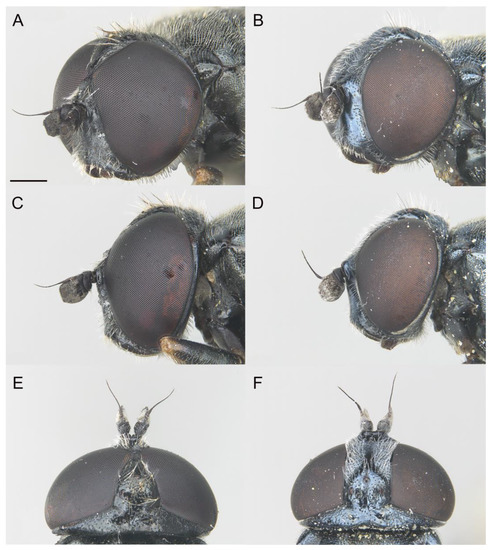
Figure 10.
Eumerus petrarum sp. n., head: (A) Male (holotype). (B) Female (paratype). Head, lateral view: (C) Male. (D) Female. Head, dorsal view: (E) Male. (F) Female. Scale bar = 500 µm.
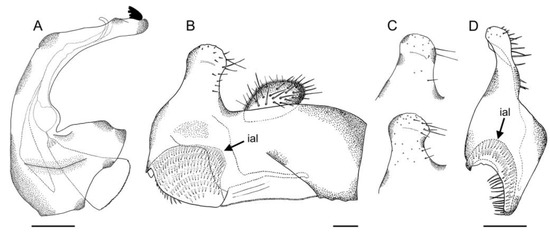
Figure 11.
Eumerus petrarum sp. n., male genitalia (holotype): (A) Hypandrium, lateral view (right side). (B) Epandrium, lateral view (right side). (C) Surstylus, intraspecific variation. (D) Epandrium, ventral view. Legend: ial, interior accessory lobe. Scale bars = (A,D) 250 µm; (B,C) 100 µm.
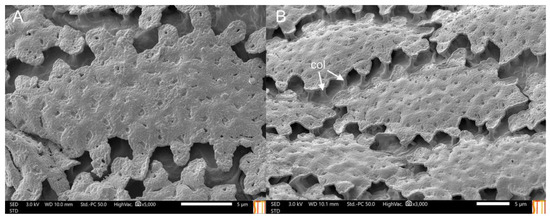
Figure 12.
Eumerus petrarum sp. n., egg: (A) Detail of the chorionic sculpture. (B) Units conforming to the chorionic sculpture. Units may touch each other in some parts because the egg was not uniformly turgid. Legend: col, columns.
- Holotype
SPAIN • ♂—ESPAÑA (GR), Sierra Nevada, Monachil, camino a Laguna de las Yeguas, 25-VI-2021, 2890 m, Leg.: A. Ricarte/DNA CEUA_S85/CEUA00109899 (CEUA-CIBIO).
- Paratypes
SPAIN • 3♂♂—ESPAÑA (GR), Sierra Nevada, Monachil, camino a Laguna de las Yeguas, 25-VI-2021, 2890 m, Leg.: A. Ricarte/CEUA00109901; 00109904; 00109904 (CEUA-CIBIO) • 5♂♂—ESPAÑA (GR), Sierra Nevada, Monachil, camino a Laguna de las Yeguas, 25-VI-2021, 2890 m, Leg.: P. Aguado Aranda/DNA CEUA_S160/CEUA00109906; 00109905 (CEUA-CIBIO); 00109902; 00109903 (AET); 00109900 (MNCN) • 4♂♂—ESPAÑA (GR), Sierra Nevada, Monachil, Sendero al Borreguil de San Juan, 22-VI-2021, 2540 m, Leg.: A. Ricarte/DNA CEUA_S83/CEUA00109885; 00109886; 00109891; 00109892 (CEUA-CIBIO) • 1♀—ESPAÑA (GR), Sierra Nevada, Monachil, Sendero al Borreguil de San Juan, 22-VI-2021, 2540 m, Leg.: A. Ricarte/DNA CEUA_S86/CEUA00109912 (CEUA-CIBIO) • 3♂♂—ESPAÑA (GR), Sierra Nevada, Monachil, Sendero al Borreguil de San Juan, 22-VI-2021, 2540 m, Leg.: Z. Nedeljković/DNA CEUA_S84/CEUA00109889; 00109890; 00109898 (CEUA-CIBIO) • 2♀♀—ESPAÑA (GR), Sierra Nevada, Monachil, Sendero al Borreguil de San Juan, 22-VI-2021, 2540 m, Leg.: Z. Nedeljković/DNA CEUA_S87/CEUA00109910; 00109911 (CEUA-CIBIO) • 3♂♂—ESPAÑA (GR), Sierra Nevada, Monachil, Sendero al Borreguil de San Juan, 22-VI-2021, 2540 m, Leg.: P. Aguado Aranda/CEUA00109888; 00109893; 00109894 (CEUA-CIBIO) • 3♂♂—ESPAÑA (GR), Sierra Nevada, Monachil, Sendero al Borreguil de San Juan, 22-VI-2021, 2540 m, Leg.: I. Ballester Torres/DNA CEUA_S161/CEUA00109895; 00109896; 00109897 (CEUA-CIBIO) • 1♂—ESPAÑA (GR), Sierra Nevada, Monachil, Borreguil de San Juan, 22-VI-2021, 2500 m, Leg.: Z. Nedeljković/CEUA00109887 (CEUA-CIBIO) • 2♂♂—ESPAÑA (GR), Sierra Nevada, Monachil, Borreguil de San Juan, 22-VI-2021, 2500 m, Leg.: Mª Á. Marcos García/CEUA00109908; 00109909 (CEUA-CIBIO) • 1♀—ESPAÑA (GR), Sierra Nevada, Monachil, Borreguil de San Juan, 22-VI-2021, 2500 m, Leg.: Mª Á. Marcos García/DNA CEUA_S93/CEUA00109883 (AET) • 1♂—ESPAÑA (GR), Sierra Nevada, Monachil, Padrollano, Estación de esquí, 20-VI-2021, 2180 m, Leg.: Z. Nedeljković/CEUA00109884 (CEUA-CIBIO) • 4♂♂—ESPAÑA (GR), Sierra Nevada, Güejar Sierra, Barranco de San Juan, 27-V-2022, 1400 m, Leg.: Z. Nedeljković/CEUA00111060; 00111061; 00111062; 00111063 (CEUA-CIBIO) • 2♂♂—ESPAÑA (GR), Sierra Nevada, Güejar Sierra, Barranco de San Juan, 27-V-2022, 1400 m, Leg.: P. Aguado/CEUA00111064; 00111065 (CEUA-CIBIO) • 2♂♂—ESPAÑA (GR), Sierra Nevada, Güejar Sierra, Barranco de San Juan, 30-V-2022, 1400 m, Leg.: Z. Nedeljković, I. Ballester & P. Aguado/CEUA00111065; 00111066 (CEUA-CIBIO) • 1♀—ESPAÑA (GR), Sierra Nevada, Güejar Sierra, Barranco de San Juan, 30-V-2022, 1400 m, Leg.: Z. Nedeljković, I. Ballester & P. Aguado/CEUA00111068 (CEUA-CIBIO) • 1♂—P.N. Sierra Nevada, Cabecera río San Juan (Granada); 37.1112 lat -3.3763 long, 2850 m, 19-07-2011 (30S6685903147), Leg: S. Santamaría/Eumerus sabulonum (Fallén, 1817), Det.: M.A. Marcos, 2012/CEUA00106009 (CEUA-CIBIO) • 1♂—N. slope Veleta, Sierra Nevada, SPAIN, 3000 m, 20.VII.1960, J.R. Vockeroth {hand written}/CNC Diptera # 156131 (CNC) {as E. sabulonum, in [50]}.
Diagnosis. This species can be distinguished by the following combination of characters: bare eyes; in males, eyes not touching along a line (Figure 10A); wide vertical triangle (0.44–0.61 mm) (Figure 10E), posterior surstylar lobe slightly constricted (Figure 11B), interior accessory lobe of the genitalia triangular-shaped (Figure 11B); in females, vertical triangle slightly elevated dorsally in lateral view (Figure 10D), occiput usually with a little orange macula on its dorsal part near the vertex. This species is most similar to E. sabulonum (see Taxonomic notes).
Etymology. The specific epithet derives from the Latin ‘petra/ae’ (rock) and refers to the fact that many specimens were collected in rocky habitats, usually resting or thermoregulating on rocks. The specific epithet ‘petrarum’ should be treated as a genitive invariable name.
Description. MALE (holotype). Measurements (mm): l = 8.3; vtw = 0.6. Head. Eyes approximated on a point, narrowly separated each other by a distance equalling the diameter of the frontal ocellus. Eye bare. Face and frontal triangle black, white pollinose and covered with white hairs. Vertical triangle black and with long, erect, white hairs. Ocellar triangle isosceles, with black and white hairs intermixed. Occiput black and purple iridescent (under artificial lighting), covered with hairs shorter than those on the vertical triangle; occiput grey pollinose along the eye margin. Scape and pedicel black; pedicel with white hairs which are longer on the ventral side. Basoflagellomere square (ratio length:width = 1:1), concave ventrally, slightly striated radially and black; basoflagellomere with a round, dark brown fossette at the distal margin. Pedicel and blasoflagellomere sparsely white pollinose (pollinosity more obvious under artificial white lighting). Arista black, bare. Thorax. Mesonotum and pleura black. Scutum covered with short, semi-reclined white hairs; scutum with two medial white pollinose vittae slightly exceeding the transverse suture; width of the vittae less than 1/8 of the total width of the scutum. Notopleural sulcus absent. Disc of scutellum with white hairs, with hairs of the same length as those on the scutum; posterior margin of the scutellum with small teeth-like protuberances, each bearing a short white hair apically. Posterior anepisternum, anterior anepimeron and katepisternum on its postero-lateral area with dense, long white hairs. Katatergum with a discrete bunch of white hairs. Pleuron grey pollinose except the posterior anepisternum antero-basally, the katepisternum anterolaterally and the posterior anepimeron. Femora black, apices light brown. Tibiae black, basal third light brown. Pro- and mesobasotarsomeres yellow. Second pro- and mesotarsomeres yellow, black at the base. Third pro- and mesotarsomeres black, ventrally yellow and black at the base. Fourth and fifth pro- and mesotarsomeres black. Metafemur with white hairs, ventrally with hairs of different lengths, including some which are as long as the subapical spinae. Metafemur with an anterior row of nine spinae and a posterior row of six spinae apicoventrally. Metatibia with a basoventral ridge covered with short, reclined and black setae. Metatarsi black; metabasotarsomere and second and third tarsomeres ventrally yellow. Wing membrane extensively microtrichose; posterior margin of the wing with dense, short and brown hairs; margin of ventral calypter with long and yellow hairs; margin of dorsal calypter with hairs shorter than that of ventral calypter; halter dark yellow. Abdomen. Terga I and IV black; posterior margin of tergum IV brownish orange. Tergum II orange. Tergum III dark orange. Terga II-IV covered with short, reclined and white hairs (black on middle area of terga II-III); anterior corners of tergum II with long and white hairs. Tergum II with a pair of rounded, white pollinose maculae; maculae on terga III-IV slightly curved. Sterna I-II orange; anterior margin of sternum I black. Sternum III orange brownish. Sternum IV black and flat (without projections); the posterior margin of sternum IV slightly convex. Sterna II-IV with short, semi-reclined white hairs. Genitalia. Epandrium with a simple posterior surstylar lobe, spatula-shaped and slightly inclined anteriorly (Figure 11B). Cercus with long hairs. Interior accessory lobe triangular-shaped (Figure 11B). Hypandrium simple, curved almost 90° in the middle (Figure 11A).
FEMALE. Same as males, besides sexual dimorphism, except for the following characters: pollinosity on face mostly present along eye margin; basoflagellomere usually 1.2 wider than long; hairs on scutum slightly shorter.
EGG. Measurements (mm): length = 0.6–0.91 (n = 10). White when recently laid but yellowish-white when older. The chorionic sculpture consists of irregularly oval-shaped units with a sinuous margin and punctured surface raised by columns. Units do not touch each other (Figure 12).
Distribution. Sierra Nevada, in Granada province (Figure 7).
Biology. Adults fly from late May to July and can be found in a wide altitudinal range (1400–3000 m) but are mainly associated with high mountain areas (>1900 m). The predominant vegetation in localities at low altitudes was woodlands (Quercus sp.) but with grasslands (‘Borreguiles’) at high altitudes.
Taxonomic notes. Eumerus petrarum sp. n. was run through the key of Eumerus from Switzerland and surrounding parts of central Europe [30] and the Stackelberg’s key to the Palaearctic Eumerus [31], keying out as E. sabulonum. The new species differs from E. sabulonum in the vertical triangle, which is wider in E. petrarum sp. n. (0.44–0.61 mm, n = 10) than in E. sabulonum (0.33–0.42 mm, n = 10); the shape of the posterior surstylar lobe, laterally constricted in E. petrarum sp. n. but square-shaped in E. sabulonum (Figure 13B); and the interior accessory lobe of the male genitalia, triangular-shaped in E. petrarum sp. n. but square in E. sabulonum (Figure 13B); in females, occiput with a little orange macula on its dorsal part close to the vertex, which is highly reduced (sometimes absent) in E. petrarum sp. n. but usually more noticeable in E. sabulonum. Furthermore, based on the examined material, E. petrarum sp. n. shows intraspecific variation in the dorsal coloration of protarsomere II (from yellow to black); the coloration of mesotarsomere III (from yellow to black); the number of spinae on the anterior row of the metafemur (six to nine); in males, the morphology of the surstylus (from more to less constricted laterally; Figure 13C); in females, body length is variable (8.04–9.48 mm; n = 5). Regarding the chorionic sculpture, the eggs of E. petrarum sp. n. are similar to those of E. sabulonum but differ on their surface, which is punctured in E. petrarum sp. n. (Figure 12) but smooth in E. sabulonum (see figure 1 of Munk [51]). In addition, the overall appearance of the eggs of E. petrarum sp. n. also resembles those of Eumerus etnensis van der Goot, 1964. However, they differ in the shape of the units, which are irregular in E. petrarum sp. n., but smooth and rounded with irregular branches in E. etnensis (see figure 2 of Pérez-Bañón & Marcos-García [52], as Eumerus purpurariae Baéz, 1982).
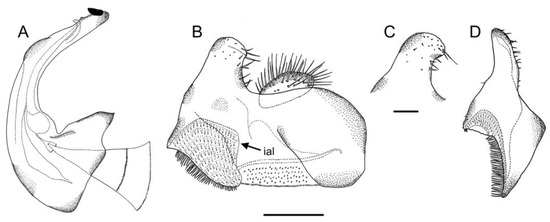
Figure 13.
Eumerus sabulonum, male genitalia: (A) Hypandrium, lateral view (right side). (B) Epandrium, lateral view (right side). (C) Surstylus, intraspecific variation. (D) Epandrium, ventral view. Legend: ial, interior accessory lobe. Scale bars = (A,B,D) 250 µm; (C) 100 µm.
According to Peck [47], three species are listed as synonyms of E. sabulonum: Eumerus litoralis Curtis, 1839, Eumerus rubriventris Macquart, 1829 and Eumerus selene Meigen, 1822. The type series of E. litoralis consists of five specimens (three males and two females) collected “on the sand hills near Christchurch” in Great Britain. All syntypes are preserved in the MMV collection. We examined pictures of the habitus and the genitalia of one male (Figure 14), which confirmed the synonymy with E. sabulonum and its differentiation with the new species. Eumerus rubriventris was described based on a single male from the north of France, without a specific locality. According to Horn & Kahle [53], the main section of the Macquart collection was destroyed. The remaining part was divided and preserved between the ‘Museum d’Historie Naturelle’ (MHNL) in Lille, the ‘Museum National d’Historie Naturelle’ (MNHNP) in Paris and the Museum of Natural History of the Oxford University (OUMNH) (Xavier Lair, in litt.). There are not records of this species neither in the MNHL (Olivier Boilly, in litt.) nor in the MNHPN and the OUMNH. Therefore, we assume that type of material is lost. Moreover, and considering the original (male) description of E. rubriventris, the vertical triangle is dark green colored, and the mesonotum exhibits an olive-green coloration, differing from the new species in which both are black. The description of E. selene is based on an undetermined number of males from an unknown locality in Europe. The only preserved specimen of this species we have been able to locate is a semi-destroyed female collected in Bavaria, labeled as “E. silene, Meig./Allemagne/1155” and deposited in the MNHNP (https://science.mnhn.fr/institution/mnhn/collection/ed/item/ed4105?listIndex=25&listCount=32, accessed on 15 March 2023). Thus, the type series of this species is apparently lost. Regarding the male description of E. selene, the white maculae on tergum II are smaller than those on tergum III, differing from the new species in which the maculae of tergum II are the widest of the three pairs.

Figure 14.
Eumerus litoralis, male (syntype), habitus: (A) Lateral view. (B) Dorsal view. Photos by Simon Hinkley (MMV).
3.3. Remarks on other Iberian Species of the E. tricolor Group
3.3.1. Eumerus azabense Ricarte & Marcos–García in Ricarte et al., 2018
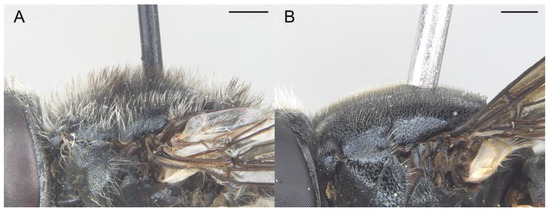
Figure 15.
Mesonotum, pilosity (male): (A) E. azabense. (B) E. tricolor. Scale bars = (A) 750 µm; (B) 500 µm.
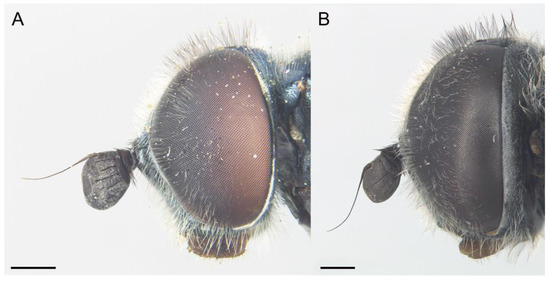
Figure 16.
Basoflagellomere, female: (A) E. ovatus. (B) E. azabense. Scale bars = 500 µm.
Distribution. New. PORTUGAL • Beja, Almograve. Published records. Revised. SPAIN • Salamanca, Campanarios de Azaba [14].
3.3.2. Eumerus bayardi Séguy, 1961
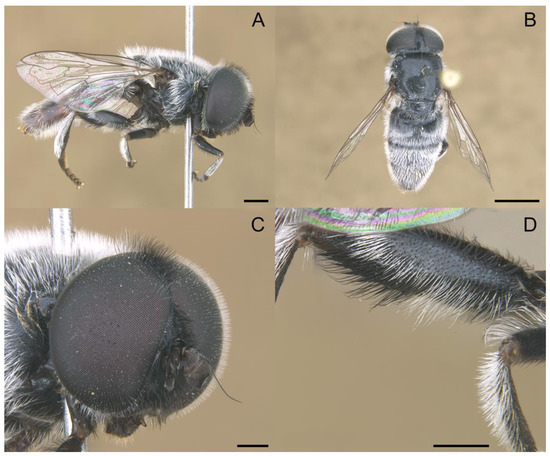
Figure 17.
Eumerus bayardi, male: (A) Habitus, lateral view. (B) Habitus, dorsal view. (C) Head. (D) Metafemur. Scale bars = (A) 1 mm; (B) 2 mm; (C,D) 500 µm.
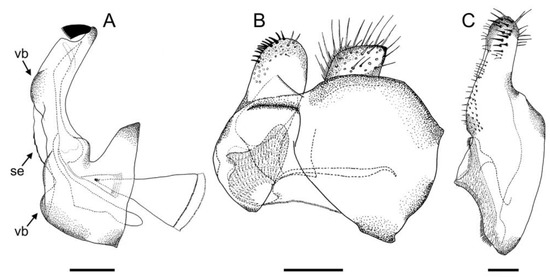
Figure 18.
Eumerus bayardi, male, genitalia: (A) Hypandrium, lateral view (right side). (B) Epandrium, lateral view (right side). (C) Epandrium, ventral view. Legend: se, serrated expansion; vb, ventral bulge. Scale bars = (A,B) 250 µm; (C) 100 µm.
Distribution. New. SPAIN • Almería, Sierra de Gádor. Published records. Revised. PORTUGAL • Beira Litoral, Serra de Santo António [54].
Genitalia. Epandrium with a simple, rounded posterior surstylar lobe; posterior surstylar lobe with thick, black setae posteriorly; epandrium with a tri-lobed interior accessory lobe (Figure 18B). Cercus rectangular-shaped and slightly pointed anteriorly. Hypandrium with two ventral bulges; hypandrium with an accessory, hyaline ventral expansion, slightly staggered at its basal part (Figure 18A).
Taxonomic notes. This species was described based on a single male⸻from the Jabron Valley (France)⸻of which we examined pictures provided by Dr. Martin Hauser. Speight et al. [55] designated E. bayardi as the valid name for Eumerus micans (Fabricius, 1798), described originally under the genus Syrphus Fabricius, 1775. According to article 57.2 of the International Code of Zoological Nomenclature (ICZN) [56], E. micans is a primary homonym of Syrphus micans (Fabricius, 1794), which was synonymized with Volucella inanis (Linnaeus, 1758) afterward [47]. The name Eumerus micans became then invalid, and the species required a new name. Speight et al. [55] indicated that the type material of E. micans is lost and that, based on the original description, no differences were found between E. micans and E. bayardi. Therefore, they synonymized and proposed E. bayardi as a replacement name for E. micans, following article 60.2 of the ICZN [56].
As a result of our integrative analysis, the status of E. bayardi as a member of the E. tricolor species group is confirmed. Based on the examined specimens, E. bayardi is similar to E. azabense but differs in the facial hairs, which are black in E. bayardi and white in E. azabense; hairs on the scutum, which are entirely white in E. bayardi but black on the central area of the scutum in E. azabense (Figure 15A); hairs on the basoventral side of the metafemur, white in E. bayardi (Figure 17D) and black in E. azabense; hairs on the abdomen, white in E. bayardi but mainly black in E. azabense; and the general shape of the surstylus in male genitalia (for E. azabense genitalia, see figure 6b of Ricarte et al. [14]).
3.3.3. Eumerus grallator Smit in Grković et al., 2019a
Distribution. New. SPAIN • Alicante, Sierra de Aitana; Almería, Sierra de Gádor; Burgos, Los Ausines; Madrid, Las Matas. Published records. Revised. SPAIN • Alicante, Agres; Valencia, Bocairent [57]. Not revised. SPAIN • Burgos, Peñahorada; Ciudad Real, Villahermosa; Granada, Bosque Mediterráneo de Puerto Navazo; Soria, Herrera de Soria [15].
Taxonomic notes. The type series of this species consists of 10 specimens collected in Spain [15]. According to the species diagnosis, one of the characters to distinguish it from other similar species is the relative length of the metatibia, which is clearly shorter than the metafemur. After the examination of further material, we have found that the length of these leg segments is variable amongst individuals (metatibia = 2.37–3.1 mm, metafemur = 2.4–3.1 mm, n = 10). The intraspecific variation in the length of these leg segments indicates that this should be avoided as a diagnostic character for species identification.
Furthermore, and based on the original description of the long-legged North African Eumerus afrarius Séguy, 1961, the males of E. grallator appear to be very similar morphologically to those of E. afrarius. Based on the original description of E. afrarius, the only differences found between the two species were the eye distance, which is equal to the diameter of an ocellus in E. grallator but twice the diameter of an ocellus in E. afrarius, and the marginal coloration of the scutellum, which is bluish-black in E. grallator but supposedly red in E. afrarius. Grković et al. [15] did not mention E. afrarius in their revision of the E. binominatus subgroup. Eumerus afrarius was described from a single male collected in Massena (Algeria), apparently preserved in the MNHNP (http://www.diptera.org/Nomenclator/Details/47859, accessed on 15 May 2023). No records of this species were found in the online database of the MNHNP, nor was information about the holotype available upon request. A potential synonymy between these two species should be further investigated in the future due to their high morphological similarity and the geographical proximity between the Iberian Peninsula and the North of Africa.
3.3.4. Eumerus grandis Meigen, 1822
Distribution. Published records. Not revised. SPAIN • Girona, Queralbs [11].
Taxonomic notes. The only known Iberian record of this species is a single female collected in the Pyrenees of Girona, near the type locality of E. ancylostylus sp. n. Since the female of E. ancylostylus sp. n. is unknown and in the absence of molecular data for the above-mentioned female, the record of E. grandis from the Pyrenees of Girona is likely to belong to E. ancylostylus sp. n. Thus, further fieldwork and molecular analyses are necessary to confirm the presence of E. grandis in the Ibero-Balearic area.
3.3.5. Eumerus hispanicus van der Goot, 1966
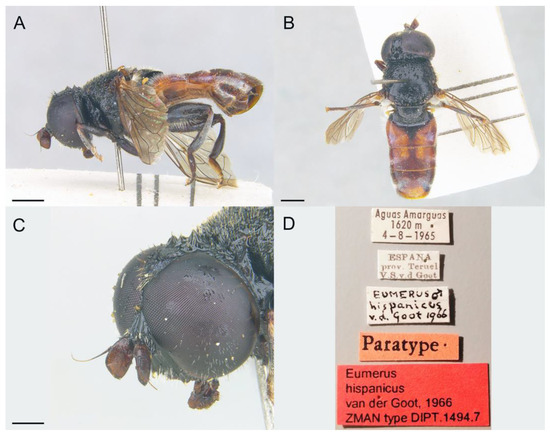
Figure 19.
Eumerus hispanicus, male (paratype): (A) Habitus, lateral view. (B) Habitus, dorsal view. (C) Head. (D) Original labels. Scale bars = (A,B) 1 mm; (C) 500 µm.
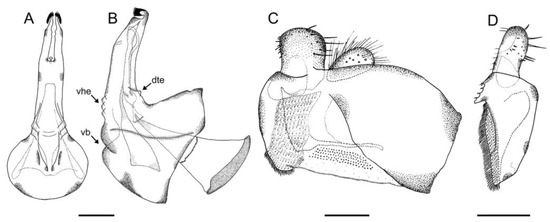
Figure 20.
Eumerus hispanicus, male genitalia (mainly based on the paratype), hypandrium: (A) Ventral view. (B) Lateral view (right side). Epandrium: (C) Lateral view (right side). (D) Ventral view. Legend: dte, dorsal triangular expansion; vb, ventral bulge; vhe, ventral hyaline expansions. Scale bars = 250 µm.
Distribution. New. SPAIN • Alicante, Sierra de Aitana, Sierra del Maigmó; Segovia, Maderuelo. Published records. Revised. SPAIN • Alicante, Agres, Jijona [57]; Teruel, Aguas Amargas [58]; Valencia, Chelva [59].
Genitalia. Epandrium with a simple posterior surstylar lobe, square-shaped and slightly rounded at the top (Figure 20C); epandrium with a rectangular-shaped, black pilose interior accessory lobe of the surstylus (Figure 20C,D). Cercus with long pilosity. Hypandrium with two round bulges basally (Figure 20B); hypandrium with three pointed, hyaline expansions basoventrally (Figure 20A,B); hypandrium with a small, triangular expansion basodorsally (Figure 20B).
3.3.6. Eumerus larvatus Aracil, Grković & Pérez-Bañón in Aracil et al., 2023
Distribution. Published records. Not revised. SPAIN • Alicante, Agost, Albatera; Almería, Sorbas, Tabernas [24].
Taxonomic notes. This species has been recently described from material collected in south-eastern Spain. The type locality is “SPAIN: Agost//Barranc de Pina” [24]. These authors separated males of E. larvatus from Eumerus compertus Villeneuve in Villeneuve & Gauthier, 1924, Eumerus mucidus Bezzi, 1921 and Eumerus turcmenorum Paramonov, 1927. Regarding E. turcmenorum, the genitalia of E. larvatus was compared with those represented in Mutin & Barkalov [60]. However, upon examination of both the genitalia of all other Iberian species of the E. tricolor group and photos of the genitalia of a supposed male of E. turcmenorum (Martin Hauser, unpublished data), we find the drawing provided by Mutin & Barkalov [60] is inconclusive; these authors appear to draw the posterior surstylar lobe in the cercus’ location, and the structures illustrated in the location of this lobe look ambiguous. In addition, Piwowarczyk & Mielczarek [61], also cited by Aracil et al. [24], provided a picture of the genitalia of E. compertus, which in fact, does not belong to E. compertus (we have examined a male of E. compertus from the CEUA-CIBIO: TUNISIEN, Bou Hedma, 15-17.3.93, leg. & det. Hauser/CEUA00017794). Although the validity of E. larvatus is not put in question, new molecular and morphological data should be used to further clarify the systematic and phylogenetic relationships amongst E. larvatus and allied species [24].
3.3.7. Eumerus ovatus Loew, 1848
(Figure 16A)
Distribution. Published records. Revised. ANDORRA • Santa Coloma (van Eck & Carles-Tolrá, in press). Not revised. SPAIN • Girona, Campelles [11], Santa Fe [62], San Marsal [63].
Taxonomic notes. Gil-Collado [63] reported this species from the localities of Santa Fe (Granada) and San Marsal (Girona). The record from the first locality was previously published by Andréu [62] based on a single male but collected close to a marsh located in Santa Fe del Montseny (Girona), not in Granada. In addition, based on the known records, this species is present in rainy, high mountain habitats, which is not the case for the Santa Fe site in Granada, southern Spain. Therefore, the citation of E. ovatus from Granada should be a misinterpretation by Gil Collado [63] of the locality data provided by Andréu [62].
3.3.8. Eumerus sabulonum (Fallén, 1817)
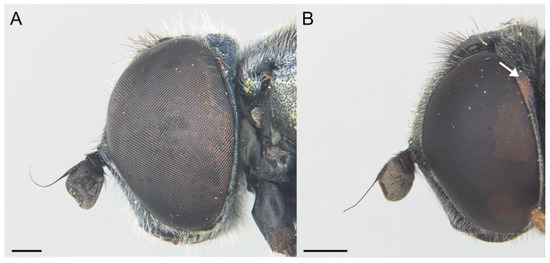
Figure 21.
Eumerus sabulonum, head, lateral view: (A) Male. (B) Female. An arrow indicates the orange macula. Scale bars = (A) 250 µm; (B) 500 µm.
Distribution. New. PORTUGAL • Faro, Corte do Gago; Viseu, Póvoa Dão • SPAIN • Ávila, Sierra de Gredos; Granada, Sierra Nevada; Navarra, Refugio de Belagua; Salamanca, Saucelle, Villar de Ciervo; Zamora, San Pedro de Nave. Published records. Revised. SPAIN • Ávila, Gilbuena; Cáceres, Arrolobos, Puerto de Honduras; Ciudad Real, Parque Nacional de Cabañeros [64]; León, Pereda de Ancares [46]; Madrid, El Ventorrillo [65]; Salamanca, Béjar [66], Navasfrías, Sierra Candelario [67]; Segovia, La Granja de San Ildefonso [66]. Not revised. PORTUGAL • Leiria, Citânia de Briteiros; Oporto, Vila do Conde [21] • SPAIN • Cáceres, Hervás; Madrid, El Escorial, Rivas, Sierra de Guadarrama; Pontevedra, La Guardia; Segovia, San Rafael; Vizcaya, Bilbao; Zamora, Bayona [63].
Taxonomic notes. The type series of E. sabulonum, described under the genus Pipiza, consists of eight specimens, and it is preserved in the entomological collection of the ‘Naturhistoriska riksmuseet’ in Stockholm (catalog numbers NHRS-GULI000070672–79). All these specimens were collected in Sweden. We could not access the type series upon request, but we included in the molecular analyses a barcode sequence of one male specimen (voucher NORSY404-12) collected in Norway, close to the type locality. We considered this specimen as the E. sabulonum sensu stricto to compare with those collected in the Iberian area.
3.3.9. Eumerus tarsalis Loew, 1848
Distribution. New. SPAIN • Granada, Sierra Nevada. Published records. Not revised. SPAIN • Barcelona [62]; Granada, Sierra Nevada [68]; Madrid, El Escorial [63].
3.3.10. Eumerus tricolor (Fabricius, 1798)
(Figure 15B)
Distribution. New. SPAIN • Alicante, Alcoleja, Planes; Burgos, Covarrubias; León, Valle de Casares; Madrid, Chinchón, Perales de Tajuña; Santander, Sotres, Vada; Valencia, Bocairent. Published records. Revised. SPAIN •Alicante, Font Roja [69]; León, Caboalles de Abajo, Mirantes de Luna, Morgovejo [46]; Madrid, Aranjuez, Montarco [63]. Not revised. SPAIN • A Coruña, Vilaboa [63].
3.4. Key to the European Species of the E. tricolor Group
The key presented below is a result of combining and adapting the key to males of the E. binominatus subgroup [15] and the key to the south-eastern European species of the E. tricolor group [11]. We decided to exclude E. lateralis from the key since its taxonomic status remains uncertain until further molecular evidence is available.
Males
- The segments of the metaleg are remarkably slender (Grković et al. [15]: figure 4) … 2 (E. binominatus subgroup)
- −
- Segments of the metaleg of normal length … 3 (other species)
- The greatest width of the metafemur is approximately equal to one-fifth of the length of the metafemur (Grković et al. [15]: figure 4) … E. grallator
- −
- The greatest width of the metafemur is approximately equal to one-eighth of the length of the metafemur (Grković et al. [15]: figure 4) … E. tenuitarsis
- The eyes are bare or nearly bare (i.e., with very short and dispersed hairs on the eye surface) … 4
- −
- The eyes are hairy … 10
- The basoflagellomere is large, about one-third of the height of the head, and yellow (Grković et al. [11]: figure 4). Tarsomeres are short, and the metabasotarsomere is longer than the other four tarsomeres of the same leg combined (Grković et al. [11]: figure 4). The ocellar triangle is isosceles in nature and closer to eye contiguity than to the upper eye margin … 5
- −
- The basoflagellomere is small, about one-quarter of the height of the head, and yellow or brown (Grković et al. [11]: figure 6). Tarsi of normal length. The ocellar triangle is wider than it is long or equilateral and closer to the upper corner of the eye than to eye contiguity … 6
- The hairs on the ventral side of the metafemur are short (Grković et al. [11]: figure 4). The male genitalia, as in figure 5 [11] … E. armatus
- −
- The hairs on the ventral side of the metafemur are very long (Grković et al. [11]: figure 4). The male genitalia, as in figures 5b1–2 [11] … E. nigrorufus
- Basoflagellomere yellow. Tergum I yellow posteriorly (Grković et al. [13]: figure 10) … E. rubrum
- −
- Basoflagellomere black or dark brown. Tergum I is entirely black … 11
- Hairs on the ventral side of the metafemur are very long and dense and clearly longer than the spinae … E. tauricus
- −
- Hairs on the ventral side of the metafemur are shorter, or only slightly longer, than the spinae … 8
- The basotarsomere and tarsomeres II–IV of the proleg each bear a long black seta posterolaterally. The male genitalia, as in figure 5d [11] … E. tarsalis
- −
- Protarsus without a long black seta … 9
- The eyes are separated, at least, by the diameter of an ocellus (Grković et al. [11]: figures 4, 6) … 11
- −
- The eyes are holoptic or, at most, separated by less than the diameter of an ocellus (Grković et al. [11]: figures 9, 11) … 14
- The basoflagellomere is yellow or red. The terga are black … 12
- −
- The basoflagellomere is black or dark brown. The terga have red maculae … 13
- Tergum IV is covered with short, golden yellow hairs (Grković et al. [11]: figure 6). Posterior surstylar lobe of male genitalia erect (Grković et al. [11]: figure 3) … E. aurofinis
- −
- Tergum IV is not covered with golden yellow hairs. The posterior surstylar lobe of the male genitalia is bent posteriorly (Grković et al. [11]: figure 3) … E. richteri
- The hairs on the mesonotum are very long. Terga II-III have large, black maculae centrally (Grković et al. [11]: figure 11) … E. sinuatus
- −
- The hairs on the mesonotum are short (Figure 15B). Terga II–II are mainly red; tergum II with triangular, black maculae anteromedially (Grković et al. [11]: figure 6) … E. tricolor
- The ventral side of the metafemur is covered with white hairs basally and black hairs distally (Figure 17D) … E. bayardi
- −
- The ventral side of the metafemur is entirely covered with unicolorous hairs… 15
- The basoflagellomere is square-shaped. Metafemur ventrally covered with long black hairs … E. larvatus
- −
- The basoflagellomere is not square-shaped. Metafemur covered with hairs of different dispositions and/or colours … 16
- The mesonotum is covered with moderately long hairs (e.g., Figure 3A) … 17
- −
- The mesonotum is covered with very long hairs (Figure 15A) … 21
- The terga are entirely black. Posterior surstylar lobe of male genitalia with a distinct lateral wing-like expansion (Grković et al. [11]: figure 3) … 18
- −
- The terga usually have red maculae laterally. The posterior surstylar lobe of the male genitalia does not have a lateral wing-like protrusion … 19
- Basoflagellomere rectangular-shaped (Grković et al. [11]: figure 9). The posterior surstylar lobe of male genitalia is short and wide (Grković et al. [11]: figure 3) … E. crispus
- −
- The basoflagellomere is trapezoidal-shaped (Grković et al. [11]: figure 2). The posterior surstylar lobe of male genitalia is long and narrow (Grković et al. [11]: figure 3) … E. arctus
- The ocellar triangle has black and white hairs intermixed. The terga are mainly red … E. hispanicus
- −
- The ocellar triangle has black hairs. The terga are black with red maculae laterally, at least, on tergum II … 20
- Terga III-IV are covered with characteristic silver-white hairs … E. ovatus
- −
- The hairs on terga II–IV are in a different arrangement … 22
- The metatibia is covered with characteristic snow-white hairs dorsally (Grković et al. [11]: figure 7). Terga II–IV entirely black with metallic blue shine (Grković et al. [11]: figure 11) … E. niveitibia
- −
- The metatibia is not covered with snow-white hairs. Terga II–IV do not have a metallic blue shine … E. azabense
Females
- The metafemur and metatibia are remarkably slender. The spinae on the ventral side of the metafemur are tiny, short and sparse (Grković et al. [11]: figure 8) … 2 (E. binominatus subgroup)
- −
- The metafemur and metatibia are more or less thickened. The spinae on the ventral side of the metafemur are arranged in rows … 3 (other species)
- The ocellar triangle has white hairs. The sterna have white hairs … E. grallator
- −
- The ocellar triangle has black hairs. The sterna have black hairs except sternum IV, covered with white hairs … E. tenuitarsis
- The eyes are bare or nearly bare … 4
- −
- The eyes are covered with conspicuous hairs … 9
- The basoflagellomere is dark brown (Grković et al. [11]: figure 6). Pro- and mesotarsomeres II-III yellow, with a black spot basally (Grković et al. [11]: figure 6) … 5
- −
- The basoflagellomere is yellow (Grković et al. [11]: figure 4). The pro- and mesotarsus are black … 7
- Protarsomeres II–IV each have a long black seta posterolaterally … E. tarsalis
- −
- The protarsus does not bear a long black seta … 6
- The basoflagellomere usually tapers toward the apex. Vertical triangle slightly elevated dorsally (Figure 10D) … E. petrarum sp. n.
- −
- The basoflagellomere is usually axe-shaped. Vertical triangle not elevated dorsally (Figure 21B) … E. sabulonum
- Basoflagellomere greatly enlarged, twice as wide as the pedicel or more (Grković et al. [11]: Figure 4). Metafemur black (Grković et al. [11]: Figure 4) … E. armatus (Greek Islands: Lesvos, Rhodes and Samos) or E. nigrorufus (Montenegro)
- −
- The basoflagellomere is small, about 1.5 times wider than the pedicel. The metafemur is yellow to red (Grković et al. [11]: Figure 8) … 8
- The ocellar triangle is wider than it is long (Grković et al. [13]: figure 12). The metafemur has a transverse suture anteriorly (Grković et al. [13]: figure 12) … E. rubrum
- −
- The ocellar triangle is equilateral or almost so (Grković et al. [13]: figure 12). The metafemur is without a transverse suture anteriorly … E. tauricus
- −
- Hairs on the mesonotum are very long (Figure 15A) … 16
- The basoflagellomere is yellow or red (Grković et al. [11]: figure 6) … 17
- −
- The basoflagellomere is black or dark brown … 12
- The eyes are covered with short, dense white hairs (Grković et al. [11]: figure 4). The metafemur is moderately thickened, covered with dense white hairs (Grković et al. [11]: figure 8e) … E. richteri
- −
- Eyes covered with tiny, scattered hairs (Grković et al. [11]: figure 6). Metafemur strongly thickened and covered with extremely short yellow hairs (Grković et al. [11]: figure 8) … E. aurofinis
- The basoventral hairs of the metafemur are longer than the spinae … 13
- −
- Basoventral hairs of the metafemur are clearly shorter than the spinae … 15
- The basoflagellomere is square-shaped … E. larvatus
- −
- The basoflagellomere is rounded … 14
- The basoflagellomere has a yellow macula basally … E. grandis
- −
- The basoflagellomere is unicolorous … E. hispanicus
- The basoflagellomere is small (Grković et al. [11]: figure 6). The terga are predominately red (Grković et al. [11]: figure 6) … E. tricolor
- −
- The basoflagellomere is big (Grković et al. [11]: figure 9). The terga are predominately black (Grković et al. [11]: figure 9) … E. crispus
- The metatibia is dorsally covered with conspicuous snow-white hairs (Grković et al. [11]: figure 8d). Terga II–III are mainly black, sometimes with reduced red maculae … E. niveitibia
- −
- The metatibia is without conspicuous snow-white hairs. Terga II–III are mainly red … 17
- The basoflagellomere is oval (Figure 16B) … E. azabense
- −
- The basoflagellomere is rounded (Figure 16A) … 18
- The basoflagellomere is moderately striated (Grković et al. [11]: figure 11) … E. ovatus
- −
- The basoflagellomere is densely striated (Grković et al. [11]: figure 11) … E. sinuatus
4. Discussion
After the present work, the number of Iberian species assigned to the E. tricolor group grows from nine to twelve (Portugal, three spp.; Spain, twelve spp.; shared species, three), and any of them has been found in the Balearic Islands. In total, six species are endemic to the Iberian Peninsula. This value of alpha diversity is similar to those found for the same species group in other European areas, such as the 13 species reported from the Balkan Peninsula [11]. The taxonomic and systematic research on the E. tricolor group is conditioned by the high levels of species richness and phenotypic diversity within some species (such as E. sabulonum), as well as the low levels of morphological differentiation for other species (e.g., E. ancylostylus sp. n. and E. grandis). In fact, there are just a few studies devoted exclusively to the taxonomy and systematics of the E. tricolor group in the Palaearctic Region [11,15,16]. The present work is the first in revising the E. tricolor group in south-western Europe and in providing a key to all its European species.
The analysis of the COI sequences revealed that E. petrarum sp. n. was not only closely related to E. sabulonum but also to E. tarsalis in a well-supported clade (Figure 2). These species share morphological features such as bare eyes and a small black basoflagellomere, among others. The fact that these sibling lineages share a common ancestor together with low levels of morphological disparity and genetic divergence are clear indicators of a recent divergence event [70]. On the contrary, the resulting trees showed that E. ancylostylus sp. n. grouped in a single clade with E. hispanicus (Figure 1 and Figure 2). These species can be distinguished by the coloration of terga, mainly red in E. hispanicus but black in E. ancylostylus sp. n. (small red maculae can appear, at least, on tergum II) and the general shape of male genitalia (Figure 5 and Figure 19). The analysis of COI sequences also suggests that both Iberian species appear to be related to E. crispus (Figure 2). This species was recently described from Serbia, in the Balkan Peninsula [11] and differs from the Iberian species in the coloration of terga, which is entirely black in E. crispus but with red maculae in E. ancylostylus sp. n. and E. hispanicus, and a lateral wing-like expansion in the posterior surstylar lobe of male genitalia, which is present in E. crispus but absent in E. ancylostylus sp. n. and E. hispanicus. The discordance between the molecular association of E. ancylostylus sp. n. and its phenotypic similarity with E. grandis appears to reflect a parallelism occurrence [70]. However, the observed polytomies underlined that the COI gene was not resolutive enough, and additional markers are required to disentangle the evolutionary relationships between these species.
In contrast with their morphological similarity with other species, both new species differ in levels of molecular divergence from their allied ones. On the one hand, E. ancylostylus sp. n. showed a 3% of divergence in COI compared to the analyzed European specimens of E. grandis. In addition, E. ancylostylus sp. n. was revealed to be more closely related to E. hispanicus (<1%) than to E. grandis (Figure 2). Thus, a speciation process giving rise to the Iberian-endemic lineages of E. ancylosytus sp. n. and E. hispanicus is plausible. On the other hand, the divergence in COI amongst the individuals of E. petrarum sp. n. and E. sabulonum was less than 1%. These are not the first reported cases of low genetic divergence between congeneric species in syrphids. For instance, Ricarte et al. [7] highlighted low divergence, in terms of COI-5′, within valid species of the brachyopine genera Melanogaster Rondani, 1857 and Lejogaster Rondani, 1857. Another example is found in the genus Merodon, as low divergence in several molecular markers was also reported within valid species [9]. Nevertheless, our species concepts are well supported by morphological data, confirming the validity of the new species. Therefore, the use of additional sets of data (e.g., genomic, geometric morphometrics), together with the morphology, is required to test the validity of cryptic and/or sibling species.
As a result of this study, the distribution ranges of the Iberian species of the E. tricolor group are now better understood (Figure 7). The two new species showed narrow ranges. Eumerus ancylostylus sp. n. was recorded from two different localities in the Euro-Siberian region of Spain, on north [26]. Although the two localities are far away from each other, both are montane areas in which the observed vegetation was derived from long periods of human use [44,46]. Similarly, E. petrarum sp. n. was collected in a mountainous area (Sierra Nevada) where this species is present from the montane zone to the highest alpine zones. The finding of these undescribed species is an indicator for the Iberian Peninsula to have acted as a climate refuge, in which the mountains were speciation centers for animals and plants during glacial-interglacial events [71,72]. Regarding the other Iberian members of the E. tricolor group, E. sabulonum was recorded for the first time from the Pyrenees of Navarra, which is the northernmost record in the Iberian territory. This species showed the most cosmopolitan distribution pattern within the Iberian Peninsula since it can be found from meridional areas, almost at sea level, to septentrional mountainous zones. This fact is consistent with the remainder of its distribution range as it is present from North Africa to the European areas of Russia [73]. Eumerus grallator was reported from Madrid and Sierra de Gádor (Almería), which is one of the most southern records of this species in the Iberian Peninsula. According to the literature and the examined material, this species is mainly present in montane areas of the Mediterranean Region. On the contrary, based on the Iberian records, E. ovatus appears to be associated with humid and rainy habitats, but it can also be found in dry and open environments where herbaceous and shrubby vegetation are predominant [73]. Nevertheless, the low number of records of E. ovatus, half of them originating from old publications [11,62,63], may indicate that its Iberian populations are declining like in other European areas [74]. Similarly, the first documented record of E. bayardi from Spain is provided on the basis of a single specimen from Almería. The taxonomic status of this species has been uncertain for a long time, as well as its presence in the Ibero-Balearic region [11,18]. Based on the two known records, E. bayardi seems to be present in low-temperature Mediterranean areas. After the present work, the morphological concept of this species is clarified, but more fieldwork is necessary in order to fill the gap of knowledge about its distribution range and biology. Moreover, the first record of E. azabense from Portugal highlights that incomplete knowledge of species distributions in the Ibero-Balearic area represents a limitation for the conservation of those species that are threatened with extinction [75]. This is particularly alarming for newly discovered species with restricted distributions (e.g., E. petrarum sp. n.). Nowadays, 16 European species of the E. tricolor group are under one of the IUCN threatened categories, of which five are present in the Iberian Peninsula. Thus, further studies in unexplored areas of the Iberian Peninsula will assist in getting a better picture of the distribution of the species of the E. tricolor group in this area and, thus, a more accurate view of their conservation status.
5. Conclusions
- (1)
- A total of 12 species of the E. tricolor group are present in the Ibero-Balearic region. A lectotype is designated for E. lateralis;
- (2)
- Two new species, E. ancylostylus sp. n. and E. petrarum sp. n., are described, illustrated and discussed;
- (3)
- From a morphological point of view, levels of intraspecific variability were high for both E. sabulonum and E. petrarum sp. n., while the interspecific variability was low between E. grandis and E. ancylostylus sp. n.;
This is the first work devoted to improving the knowledge about the diversity, systematics and distribution of the E. tricolor species group in the Iberian area.
Supplementary Materials
The following supporting information can be downloaded at: https://www.mdpi.com/article/10.3390/insects14060541/s1, Table S1: List of examined material; Table S2: List of species/specimens analyzed in the molecular study.
Author Contributions
Conceptualization, P.A.-A., A.R. and Z.N.; Data curation, P.A.-A. and Z.N.; Formal analysis, P.A.-A.; Funding acquisition, A.R. and J.H.S.; Investigation, A.R., Z.N. and M.Á.M.-G.; Methodology, P.A.-A., A.R., S.K., A.P.W.v.E. and M.Á.M.-G.; Project administration, A.R. and S.K.; Resources, A.R., J.H.S. and M.Á.M.-G.; Software, Z.N.; Supervision, A.R., S.K. and M.Á.M.-G.; Writing—original draft, P.A.-A.; Writing—review & editing, P.A.-A., A.R., Z.N., A.P.W.v.E. and M.Á.M.-G. All authors have read and agreed to the published version of the manuscript.
Funding
The present work is part of Pablo Aguado-Aranda’s Ph.D. thesis (Ref. PRE2019-087508) and was funded by the ‘Fauna Ibérica’ project (Ref. PGC2018-095851-A-C65) of the ‘Ministerio de Ciencia e Innovación,’ Spain. Antonio Ricarte’s position at the University of Alicante (Ref. UATALENTO17-08) is funded by the ‘Vicerrectorado de Investigación y Transferencia del Conocimiento.’ Jeffrey H. Skevington’s position is funded by an A-base research grant from Agriculture and Agri-Food Canada (AAFC).
Data Availability Statement
All sequences generated in this work are available in the publicly accessible repository of GenBank (https://www.ncbi.nlm.nih.gov/genbank/).
Acknowledgments
We are very grateful to Pasquale Ciliberti and Wendy van Boheme (NBC) for the loan of a male paratype of E. hispanicus, Rune Bygebjerg (MZLU) for the loan of the type material of E. lateralis, Simon Hinkley (MMV) for the pictures of a male syntype of E. litoralis and Mercedes París (MNCN) for the loan of several specimens of different species examined in this work. Our gratitude to Miguel Ángel Alonso Zarazaga for his nomenclatural advice, José Javier Orengo Green for his help with the preparation and study of the eggs and Iván Ballester Torres and Eduardo Galante for their participation in the fieldwork. We also thank Martin Hauser for providing pictures of the holotype of E. bayardi and male genitalia of E. turcmenorum, Deuk-Soo Choi for the barcode sequence of E. platycodon, Jeroen van Steenis for providing and donating a female of E. tarsalis to the CEUA-CIBIO collection and Sander Bot for providing a male of E. azabense from Portugal. The first author especially thanks Gil Felipe Gonçalves Miranda, Behnam Motamedinia and Samantha Dizon for their help, support and kindness during his research stay at the CNC. We also thank the three anonymous reviewers for their comments and suggestions, which have proven useful to improve this work.
Conflicts of Interest
The authors declare no conflict of interest. The funders had no role in the design of the study; in the collection, analyses, or interpretation of data; in the writing of the manuscript, or in the decision to publish the results.
References
- Marshall, S.A. Flies: The Natural History and Diversity of Diptera; Firefly Books Ltd.: Richmond Hill, ON, Canada, 2012; pp. 1–616. [Google Scholar]
- Ballester-Torres, I.; Ricarte, A.; Nedeljković, Z.; Marcos-García, M.Á. High phenotypic diversity does not always hide taxonomic diversity: A study case with Cheilosia soror (Zetterstedt, 1843) (Diptera: Syrphidae) in the Iberian Peninsula. J. Zool. Syst. Evol. Res. 2022, 2022, 8378483. [Google Scholar] [CrossRef]
- Vujić, A.; Radenković, S.; Likov, L.; Veselić, S. Taxonomic complexity in the genus Merodon Meigen, 1803 (Diptera, Syrphidae). ZooKeys 2021, 1031, 85–124. [Google Scholar] [CrossRef] [PubMed]
- Ennos, R.A.; French, G.C.; Hollingsworth, P.M. Conserving taxonomic complexity. TRENDS Ecol. Evol. 2005, 20, 164–168. [Google Scholar] [CrossRef] [PubMed]
- Struck, T.H.; Cerca, J. Cryptic species and their evolutionary significance. Encycl. Life Sci. 2019, 2019, 1–9. [Google Scholar]
- Nedeljković, Z.; Ricarte, A.; Šašić Zorić, L.; Djan, M.; Hayat, R.; Vujić, A.; Marcos-García, M.Á. Integrative taxonomy confirms two new West-Palaearctic species allied with Chrysotoxum vernale Loew, 1841 (Diptera: Syrphidae). Org. Divers. Evol. 2020, 20, 821–833. [Google Scholar] [CrossRef]
- Ricarte, A.; Nedeljković, Z.; Aguado-Aranda, P.; Marcos-García, M.Á. Assessing the Diversity and Systematics of Brachyopini Hoverflies (Diptera: Syrphidae) in the Iberian Peninsula, Including the Descriptions of Two New Species. Insects 2022, 13, 648. [Google Scholar] [CrossRef] [PubMed]
- Knowlton, N. Cryptic and Sibling Species among the Decapod Crustacea. J. Crustacean Biol. 1986, 6, 356–363. [Google Scholar] [CrossRef]
- Vujić, A.; Radenković, S.; Likov, L.; Andrić, A.; Janković, M.; Ačanski, J.; Popov, G.; de Courcy Williams, M.; Šašić Zorić, L.; Djan, M. Conflict and congruence between morphological and molecular data: Revision of the Merodon constans group (Diptera: Syrphidae). Invertebr. Syst. 2020, 34, 406–448. [Google Scholar] [CrossRef]
- Ricarte, A.; Souba-Dols, G.J.; Hauser, M.; Marcos-García, M.Á. A review of the early stages and host plants of the genera Eumerus and Merodon (Diptera: Syrphidae), with new data on four species. PLoS ONE 2017, 12, e0189852. [Google Scholar] [CrossRef]
- Grković, A.; van Steenis, J.; Miličić, M.; Kočiš Tubić, N.; Djan, M.; Radenković, S.; Vujić, A. Taxonomic revision of the highly threatened Eumerus tricolor species group (Diptera: Syrphidae) in Southeast Europe, with insights into the conservation of the genus Eumerus. Eur. J. Entomol. 2021, 118, 368–393. [Google Scholar] [CrossRef]
- Chroni, A.; Djan, M.; Vidaković, D.O.; Petanidou, T.; Vujić, A. Molecular species delimitation in the genus Eumerus (Diptera: Syrphidae). Bull. Entomol. Res. 2017, 107, 126–138. [Google Scholar] [CrossRef] [PubMed]
- Grković, A.; Vujić, A.; Chroni, A.; van Steenis, J.; Djan, M.; Radenković, S. Taxonomy and systematics of three species of the genus Eumerus Meigen, 1822 (Diptera: Syrphidae) new to southeastern Europe. Zool. Anz. 2017, 270, 176–192. [Google Scholar] [CrossRef]
- Ricarte, A.; Nencioni, A.; Kočiš Tubić, N.; Grković, A.; Vujić, A.; Marcos-García, M.Á. The hoverflies of an oak dehesa from Spain, with a new species and other insights into the taxonomy of the Eumerus tricolor group (Diptera: Syrphidae). Ann. Zool. 2018, 68, 259–280. [Google Scholar] [CrossRef]
- Grković, A.; Smit, J.; Radenković, S.; Vujić, A.; van Steenis, J. Two new European long-legged hoverfly species of the Eumerus binominatus species subgroup (Diptera, Syrphidae). ZooKeys 2019, 858, 91–108. [Google Scholar] [CrossRef] [PubMed]
- Gilasian, E.; van Steenis, J.; Parchami-Araghi, M. Review of the Eumerus tricolor species group (Diptera: Syrphidae) in Iran, with description of six new species. Eur. J. Taxon. 2020, 722, 106–152. [Google Scholar] [CrossRef]
- Vujić, A.; Gilbert, F.; Flinn, G.; Englefield, E.; Ferreira, C.C.; Varga, Z.; Eggert, F.; Woolcock, S.; Böhm, M.; Mergy, R.; et al. Pollinators on the Edge: Our European Hoverflies; The European Red List of Hoverflies; European Commission: Brussels, Belgium, 2022; pp. 1–96. [Google Scholar]
- Ricarte, A.; Marcos-García, M.Á. A checklist of the Syrphidae (Diptera) of Spain, Andorra and Gibraltar. Zootaxa 2017, 4216, 401–440. [Google Scholar] [CrossRef] [PubMed]
- Ricarte, A.; Aguado-Aranda, P.; Nedeljković, Z. Some remarkable findings within the subtribe Helophilina (Diptera, Syrphidae) from the island of Menorca, Spain. Bol. Asoc. Esp. Entomol. 2022, 46, 327–329. [Google Scholar]
- van Eck, A. A checklist of the hoverflies of Portugal (Diptera, Syrphidae). Bol. Soc. Entomol. Aragonesa (S.E.A.) 2011, 49, 127–144. [Google Scholar]
- van Eck, A. Hoverflies (Diptera, Syrphidae) new to the fauna of Mainland Portugal, with and updated hoverfly checklist. Bol. Soc. Entomol. Aragonesa (S.E.A.) 2016, 59, 187–203. [Google Scholar]
- Aguado-Aranda, P.; Ricarte, A.; Marcos-García, M.Á. Present and future of the knowledge about the genus Eumerus Meigen, 1822 (Diptera: Syrphidae) in the Iberian Peninsula. Cuad. Biodivers. 2022, 63, 40–48. [Google Scholar] [CrossRef]
- Aguado-Aranda, P.; Ricarte, A.; Nedeljković, Z.; Marcos-García, M.Á. An overlooked case for a century: Taxonomy and systematics of a new Iberian species of Eumerus Meigen, 1822 (Diptera, Syrphidae). Eur. J. Taxon. 2022, 817, 35–57. [Google Scholar] [CrossRef]
- Aracil, A.; Grković, A.; Pérez-Bañón, C.; Kočiš Tubić, N.; Juan, A.; Radenković, S.; Vujić, A.; Rojo, S. A new species of phytophagous flower fly (Diptera, Syrphidae), feeding on holoparasitic broomrape plants (Orobanchaceae) for the first time in Europe. Arthropod-Plant Interact. 2023, 2023, 18. [Google Scholar] [CrossRef]
- Grković, A.; van Steenis, J.; Kočiš Tubić, N.; Nedeljković, Z.; Hauser, M.; Hayat, R.; Demirözer, O.; Djan, M.; Vujić, A.; Radenković, S. Revision of the bactrianus subgroup of the genus Eumerus Meigen (Diptera: Syrphidae) in Europe, inferred from morphological and molecular data with descriptions of three new species. Arthropod Syst. Phylogeny 2019, 77, 21–37. [Google Scholar] [CrossRef]
- Rivas-Martínez, S.; Penas, Á.; Díaz-González, T.E.; del Río, S.; Cantó, P.; Herrero, L.; Pinto-Gomes, C.; Costa, J.C. Biogeography of Spain and Portugal. Preliminary typological synopsis. Int. J. Geobot. Res. 2014, 4, 1–64. [Google Scholar]
- García-Codron, J.C. El medio físico. In La Naturaleza de España; Reyero, J.M., Ed.; Ministerio de Medio Ambiente: Madrid, Spain, 2002; pp. 18–33. [Google Scholar]
- QGIS Geographic Information System. Ver. 3.22. Open Source Geospatial Foundation. Available online: https://qgis.org (accessed on 8 March 2023).
- Séguy, E. Diptères syrphides d’Europe Occidentale; Muséum National d’Historie Naturelle: Paris, France, 1961; pp. 1–248. [Google Scholar]
- Speight, M.C.D.; Fisler, L.; Pétremand, G.; Hauser, M. A key to the males of the Eumerus species known from Switzerland & surrounding parts of central Europe (Diptera: Syrphidae). Syrph Net Database Eur. Syrphidae 2021, 112, 1–36. [Google Scholar]
- Stackelberg, A.A. Palaearctic species of the genus Eumerus Mg. (Diptera, Syrphidae). Tr. Vsesojuoznogo Entomol. Obs. 1961, 48, 181–229. [Google Scholar]
- Ricarte, A.; Nedeljković, Z.; Rotheray, G.E.; Lyszkowski, R.; Hancock, E.; Watt, K.; Hewitt, S.; Horsfield, D.; Wilkinson, G. Syrphidae (Diptera) from the Greek island of Lesvos, with description of two new species. Zootaxa 2012, 3175, 1–23. [Google Scholar] [CrossRef]
- Thompson, F.C. A key to the genera of the flower flies (Diptera: Syrphidae) of the Neotropical Region including descriptions of new genera and species and a glossary of taxonomic terms. Contrib. Entomol. Int. 1999, 3, 321–378. [Google Scholar]
- Doczkal, D.; Pape, T. Lyneborgimyia magnifica gen. et sp.n. (Diptera: Syrphidae) from Tanzania, with a phylogenetic analysis of the Eumerini using new morphological characters. Syst. Entomol. 2009, 34, 559–573. [Google Scholar] [CrossRef]
- Doczkal, D. Description of two new species of the genus Eumerus Meigen (Diptera, Syrphidae) from Corsica. Volucella 1996, 2, 3–19. [Google Scholar]
- Chandler, A.E.F. A preliminary key to the eggs of some of the commoner aphidophagous Syrphidae (Diptera) occurring in Britain. Trans. R. Entompl. Soc. Lond. 1968, 120, 199–217. [Google Scholar] [CrossRef]
- Grković, A.; Vujić, A.; Radenković, S.; Chroni, A.; Petanidou, T. Diversity of the genus Eumerus Meigen (Diptera, Syrphidae) on the eastern Mediterranean islands with description of three new species. Ann. Soc. Entomol. Fr. (N.S.) 2015, 51, 361–373. [Google Scholar] [CrossRef]
- Ratnasingham, S.; Hebert, P.D.N. BOLD: The Barcode of Life Data system (http://www.barcodinglife.org). Mol. Ecol. Notes 2007, 7, 355–364. [Google Scholar] [CrossRef] [PubMed]
- Larsson, A. AliView: A fast and lightweight alignment viewer and editor for large datasets. Bioinformatics 2014, 30, 3276–3278. [Google Scholar] [CrossRef] [PubMed]
- Kumar, S.; Stecher, G.; Tamura, K. MEGA7: Molecular evolutionary genetics analysis version 7.0 for bigger datasets. Mol. Biol. Evol. 2016, 33, 1870–1874. [Google Scholar] [CrossRef] [PubMed]
- Folmer, D.; Black, M.B.; Hoch, W.; Lutz, R.A.; Vrijehock, R.C. DNA primers for amplification of mitochondrial cytochrome oxidase subunit I from diverse metazoan invertebrates. Mol. Mar. Biol. Biotechnol. 1994, 3, 294–299. [Google Scholar]
- Gibson, J.F.; Kelso, S.; Jackson, M.D.; Kits, J.H.; Miranda, G.F.G.; Skevington, J.H. Diptera-Specific Polymerase Chain Reaction Amplification Primers of Use in Molecular Phylogenetic Research. Ann. Entomol. Soc. Am. 2011, 104, 976–997. [Google Scholar] [CrossRef]
- Simon, C.; Frati, F.; Beckenbach, A.; Crespi, B.; Liu, H.; Flook, P. Evolution, weighting, and phylogenetic utility of mitochondrial gene sequences and a compilation of conserved polymerase chain reaction primers. Ann. Entomol. Soc. Am. 1994, 87, 651–701. [Google Scholar] [CrossRef]
- Ricarte, A.; Nedeljković, Z.; Marcos-García, M.Á. An exploratory survey and assessment of the hoverfly diversity (Diptera: Syrphidae) from the Pyrenees of Girona, Spain. Rev. Suisse Zool. 2021, 128, 381–398. [Google Scholar] [CrossRef]
- Marcos-García, M.A. Nuevas especies de Eristalinae para la fauna ibérica (Diptera, Syrphidae). Nouv. Rev. D’entomol. 1990, 7, 317–323. [Google Scholar]
- Marcos-García, M.A. Catálogo preliminar de los Syrphidae (Diptera) de la Cordillera Cantábrica (España). Eos 1990, 66, 83–100. [Google Scholar]
- Peck, L.V. Syrphidae. In Catalogue of Palaearctic Diptera; Soós, A., Papp, L., Eds.; Akadémiai Kiadó: Budapest, Hungary, 1988; Volume 8, pp. 11–230. [Google Scholar]
- Vujić, A.; Tot, T.; Andrić, A.; Ačanski, J.; Šašić Zorić, L.; Pérez-Bañón, C.; Aracil, A.; Veselić, S.; Arok, M.; Mengual, X.; et al. Review of the Merodon natans group with description of a new species, a key to the adults of known species of the natans lineage and first descriptions of some preimaginal stages. Arthropod Syst. Phylogeny 2021, 79, 343–378. [Google Scholar] [CrossRef]
- Meigen, J.W. Systematische Beschreibung der Bekannten Europäischen Zweiflugeligen Insekten. Dritter Theil; Beaufort Sohn: Aachen, Germany, 1822; pp. 1–416. [Google Scholar]
- Pedersen, T.E. Some Syrphidae from Spain, with descriptions of two new species (Insecta, Diptera). Steenstrupia 1971, 1, 229–245. [Google Scholar]
- Munk, T. The hoverfly Eumerus sabulonum (Fallén, 1817) (Syrphidae, Diptera) breeds in Sheep’s Bit (Jasione montana L.). Flora Fauna 2000, 106, 19–22. [Google Scholar]
- Pérez-Bañón, C.; Marcos-García, Á. Life history and description of the immature stages of Eumerus purpurariae (Diptera: Syrphidae) developing in Opuntia maxima. Eur. J. Entomol. 1998, 95, 373–382. [Google Scholar]
- Horn, W.; Kahle, I. Über entomologische Sammlungen (Ein Beitrag zur Geschichte der Entomo-Museologie). Teil II. Entomol. Beih. Berl.-Dahl. 1936, 3, 161–306. [Google Scholar]
- van Eck, A.P.W.; Andrade, R.A.M.; van Steenis, W.; van der Ent, L.-J. New additions to the hoverflies of mainland Portugal (Diptera, Syrphidae) with some observations on flower visits. Bol. Soc. Entomol. Aragonesa (S.E.A.) 2020, 66, 193–198. [Google Scholar]
- Speight, M.C.D.; Claussen, C.; Hurkmans, W. Révision des syrphes de la faune de France: III—Liste alphabétique des espèces des genres Cheilosia, Eumerus et Merodon et Supplemént (Diptera, Syrphidae). Bull. Soc. Entomol. Fr. 1998, 103, 401–414. [Google Scholar] [CrossRef]
- International Commission on Zoological Nomenclature. The International Code of Zoological Nomenclature, 4th ed.; The International Trust for Zoological Nomenclature: London, UK, 1999; pp. 1–156. [Google Scholar]
- Mengual, X. Diversidad Biológica de los Sírfidos (Diptera: Syrphidae) Asociada a la Actividad Humana en áreas Protegidas de la Provincia de Alicante. Graduate Thesis, University of Alicante, Alicante, Spain, 2005. [Google Scholar]
- van der Goot, V.S. Two new species of Syrphidae (Dipt.) from Spain. Entomol. Ber. 1966, 26, 179–183. [Google Scholar]
- Pérez-Bañón, C. Estudio de la Comunidad de Sírfidos de las Sierras Valencianas del Negrete y Utiel (Diptera, Syrphidae). Graduate Thesis, University of Alicante, Alicante, Spain, 1995. [Google Scholar]
- Mutin, V.A.; Barkalov, A.V. New data on the hover-flies of the genus Eumerus (Diptera: Syrphidae) from Russia. Far East. Entomol. 2018, 363, 11–20. [Google Scholar] [CrossRef]
- Piwowarczyk, R.; Mielczarek, L. First report of Eumerus mucidus (Diptera: Syrphidae) on Cistanche armena (Orobanchaceae) and from Armenia. Fla. Entomol. 2018, 101, 519–521. [Google Scholar] [CrossRef]
- Andréu, J. Notas dipterológicas. Una lista de sírfidos para contribuir al conocimiento de los dípteros de España. Bol. Soc. Entomol. Esp. 1926, 9, 98–126. [Google Scholar]
- Gil-Collado, J. Monografía de los Sírfidos de España. Trab. Mus. Nac. Cienc. Nat. 1930, 54, 1–376. [Google Scholar]
- Ricarte, A. Biodiversidad de Sírfidos (Diptera: Syrphidae) y Conservación de los Hábitats en el Parque Nacional de Cabañeros, España. Ph.D. Thesis, University of Alicante, Alicante, Spain, 2008. [Google Scholar]
- Lorenzo, D.; Ricarte, A.; Nedeljković, Z.; Nieves-Aldrey, J.L.; Marcos-García, M.A. Hoverflies (Diptera: Syprhidae) of El Ventorrillo Biological Station, Madrid province, Spain: A perspective from a late twentieth century inventory. Rev. Suisse Zool. 2020, 127, 393–412. [Google Scholar] [CrossRef]
- van Eck, A. Poorly recorded Syrphidae (Diptera) from Spain including species new to its fauna. Bol. Soc. Entomol. Aragonesa (S.E.A.) 2010, 46, 299–300. [Google Scholar]
- Marcos-García, M.Á. Los Syrphidae (Dip.) de las sierras occidentales del Sistema Central español. Subfamilias: Eristalinae, Lampettiinae, Microdontinae, Milesiinae y Cerianinae. Bol. Asoc. Esp. Entomol. 1985, 9, 187–210. [Google Scholar]
- van der Goot, V.S. Quelques Syrphides (Dipt.) des Pyrénées et de la Sierra Nevada. Entomol. Ber. 1958, 18, 93–96. [Google Scholar]
- Sonet, L. Taxócenose des syrphes (Diptera: Syrphidae) associée à un champ d’amandiers dans le Parc Naturel du Carrascal de la Font Roja. Biology. Degree Thesis, University of Alicante, Alicante, Spain, 1994. [Google Scholar]
- Struck, T.H.; Feder, J.L.; Bendiksby, M.; Birkeland, S.; Cerca, J.; Gusarov, V.I.; Kistenich, S.; Larsson, K.-H.; Liow, L.H.; Nowak, M.D.; et al. Finding Evolutionary Processes Hidden in Cryptic Species. Trends Ecol. Evol. 2018, 33, 153–163. [Google Scholar] [CrossRef]
- Médail, F.; Diadema, K. Glacial refugia influence plant diversity patterns in the Mediterranean Basin. J. Biogeogr. 2009, 36, 1333–1345. [Google Scholar] [CrossRef]
- Wallis, G.P.; Waters, J.M.; Upton, P.; Craw, C. Transverse Alpine Speciation Driven by Glaciation. TRENDS Ecol. Evol. 2016, 31, 916–926. [Google Scholar] [CrossRef]
- Speight, M.C.D. Species accounts of European Syrphidae, 2020. In Syrph the Net, the Database of European Syrphidae (Diptera); Syrph the Net publications: Dublin, Ireland, 2020; Volume 104, pp. 1–314. [Google Scholar]
- Grković, A. Eumerus ovatus. The IUCN Red List of Threatened Species. 2021, e.T149169669A149169679. Available online: https://doi.org/10.2305/IUCN.UK.2021-3.RLTS.T149169669A149169679.en (accessed on 28 March 2023).
- Grković, A. Eumerus azabense. The IUCN Red List of Threatened Species. 2021, e.T149169268A149169278. Available online: https://doi.org/10.2305/IUCN.UK.2021-3.RLTS.T149169268A149169278.en (accessed on 28 March 2023).
Disclaimer/Publisher’s Note: The statements, opinions and data contained in all publications are solely those of the individual author(s) and contributor(s) and not of MDPI and/or the editor(s). MDPI and/or the editor(s) disclaim responsibility for any injury to people or property resulting from any ideas, methods, instructions or products referred to in the content. |
© 2023 by the authors. Licensee MDPI, Basel, Switzerland. This article is an open access article distributed under the terms and conditions of the Creative Commons Attribution (CC BY) license (https://creativecommons.org/licenses/by/4.0/).